Table of Contents
- Post-Helpful Content update, link building must prioritize authenticity, experience, and original, people-first content.
- Link quality trumps quantity, so avoid “bad neighborhoods” and low-quality guest posts or link exchange sites.
- Ego bait, digital PR, and passive link magnets (such as statistics pages) remain effective.
- Quote pitching and unlinked mention tracking are gaining value for showcasing E-E-A-T and securing editorial links.
- Evaluate sites rigorously before outreach: avoid spammy DA-chasers, check for subdomains, and ensure helpful content.
This post isn’t your typical list of link building strategies.
(In fact, most link building strategy posts technically list “tactics,” not strategies. Yet, I digress.)
I’m not going to list 175+ tactics that can get you links. I’m not even confident there are 175 these days.
As you have undoubtedly heard (or perhaps experienced firsthand), Google took a sledgehammer to a chunk of the most popular tactics and has been slowly draining others.
So, I want to outline the best link-building strategies, tactics, and tips based on the industry’s direction after Google’s Helpful Content update.
Let’s examine the data using real-life examples—not just theories—of the future of link-building strategies for 2024 and beyond.
How Has the Helpful Content Update Changed Link Building
Let’s start by setting the state of affairs.
The most recent Helpful Content Update was in March 2024, but there have been several others since Google first announced it in August 2022.
The TLDR version of each update is that Google wants to define and reward quality content.
However, since quality isn’t a qualitative metric, we need to dig deeper into their documentation for Helpful Content, which provides a self-assessment for building “helpful” content.
In essence, they want you to:
- Write for people, not search engines
- Display actual experience and expertise in the topic
- Properly source information
- Provide comprehensive topic coverage
- Originality (either in data or writing)
I wrote about that a bit in my post about Helpful Content.
However, because the extent to which they can quantify much of this is unclear, we have to look at the available data.
Cyrus Sheppard did a great analysis of the winners and losers from Google’s 2023 update.
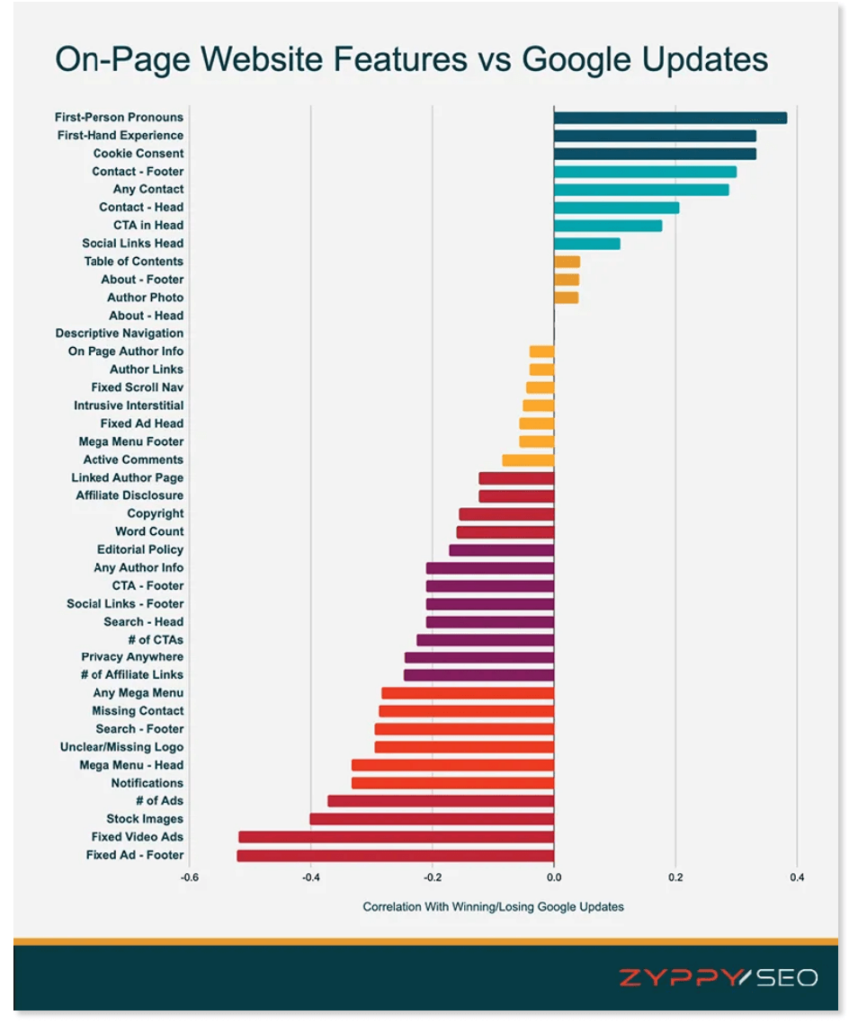
With insights like these, we can connect the dots between what Google says and what/how they are implementing it.
For example, first-hand experience and first-person pronouns are at the top, showing how highly Google values experience. Google preaches the importance of displaying “experience” in their Helpful Content documentation.
In the March 2024 Core Update, Google doubled down and announced that it had incorporated its preexisting “helpful content system” into its core ranking systems.
Let’s look at some data to understand some of the more qualitative aspects of the helpful content system.
Lily Ray and Silvia Gituto of Amisive provided another great analysis of the winners/losers.
In the analysis, the losers are more of the same:
Sites taking shortcuts (and failing) to produce “helpful” content don’t display quality E-E-A-T. They only write for search rather than for humans.
Some examples:
- Travel blogs using stock photography vs actual photos from being there.
- Sites write short, unhelpful answers to ‘People Also Ask’ queries just to fulfill the search.
- Sites spin out AI-written content with no editorial oversight.
Google is trying to reward sites that write authentic, well-researched content. The sites that are failing are simply not doing it.
So, What Does That Mean For Link Building?
Many sites we thought were worth building links from are less likely to drive value because Google has raised the bar on quality.
You need to do deeper quality checks to see where you are getting your links. For example, if a site becomes lax with its guest posting requirements, it quickly becomes a low-quality link.
The site goes from getting a thumbs up from a good site to a thumbs up from one that Google thinks is spammy. Brian Dean calls it a “bad neighborhood” link in our podcast episode.
“So what happens is a lot of times they’re like, no gambling, crypto, CBD, blah, to make it seem kind of legit. And then they eventually allow like a borderline one and then it’s a free for all.
And then your link all of a sudden goes from like, Oh, this is a really nice link to like on a spammy site with bad neighborhoods as I used to call it.”
So, with all of that in mind, here are the best link building strategies going forward.
Creating and Pitching Helpful Content to Other Helpful Sites
You could have the greatest content in the world, but if no one sees it, it’s not worth much for SEO.
So, to get links, you need to pitch the content.
The most effective tactics that most take are:
- Mention Outreach
- Digital PR/News Outreach
- Press Releases
- Blogger Outreach
- Broken Link Content Creation
Let’s dig into each.
1. Ego Bait or Mention Outreach
TL:DR: Still useful. It is more challenging to find people willing to link back.
In this approach, you mention a brand, person, or website in your post and then email them to let them know you’ve mentioned them in the hope that they will add a link.
This is known as “ego bait” because you are appealing to their ego and mention outreach because you are reaching out to people mentioned in the piece.
Although there is some crossover between this and digital PR (mentioned next), the location-based data studies are prime examples of using ego bait and mention outreach as your link building strategy.
For instance, this post created for Homebuyer.com outlines the most affordable cities in the U.S. to buy a home.
The local news outlets in the cities mentioned on the list all became link building targets.
Does It Still Work?
Yes, definitely.
In fact, we just did it on our digital PR tools post (which came out mid-Helpful Content update and is ranking #1 at the time of this writing).
In this post, I referenced several great tools that I actually use. Then, I emailed those tools and let them know I mentioned them in our post.
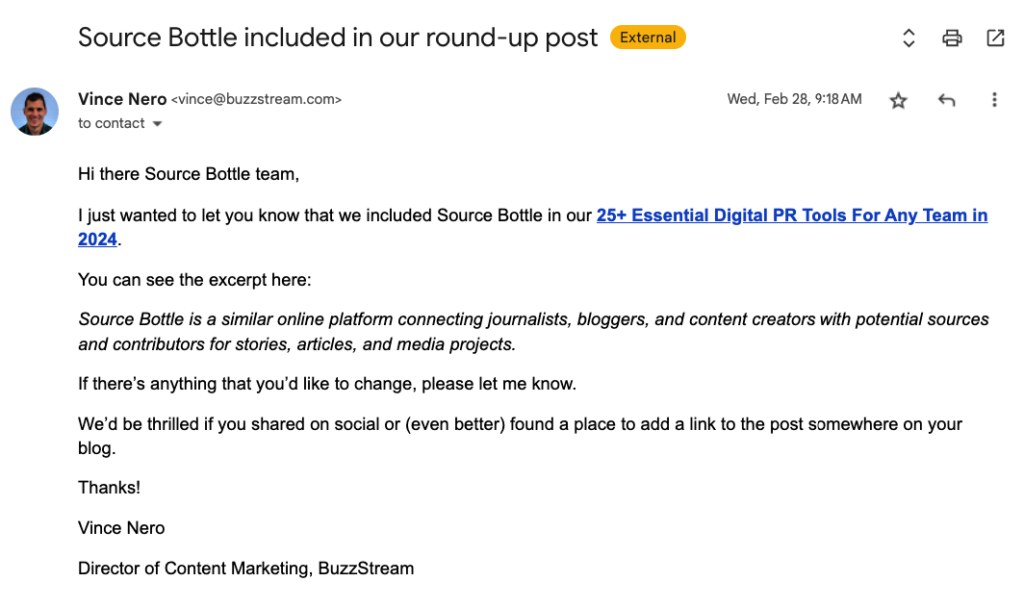
And a few were flattered and gave us a link back:
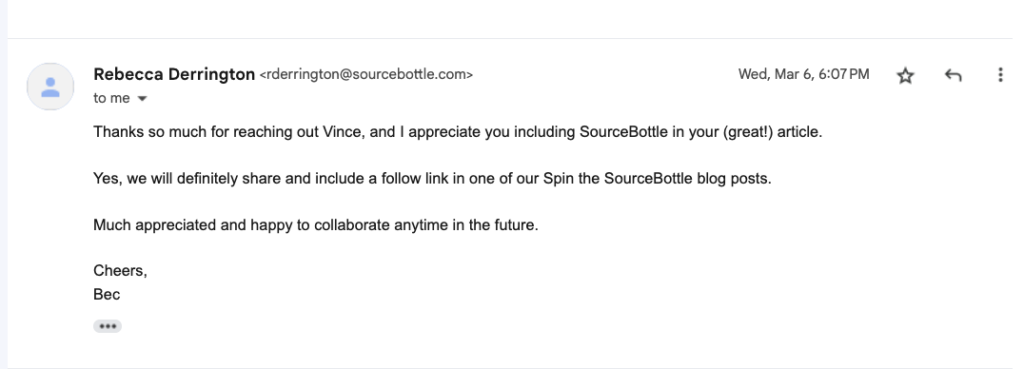
How to Be Effective in 2024
It is becoming much harder to find willing participants. Users know this is an SEO play, so you will likely get ignored.
To be effective these days, try to find less common targets, people who will really be flattered when you include them.
To do this, include longer tail keywords and unique categories within your content.
For example, if I wanted to write a post about SEO Trends From X (aka Twitter), instead of including Tweets from well-known SEO mainstays like Rand Fishkin or Wil Reynolds.
Instead, I would look for newer voices in the community.
Or, if I were going to write (another post) about Digital PR tools, maybe I’d tweak the angle of the piece to be “New Digital PR Tools Released in 2024: Reviewed” or “Digital PR Tools You’ve Never Heard Of.”
Anything I can do to surface new, underserved markets.
However, it’s important not to be inauthentic. If you become too strategic about who you include or exclude, you may sacrifice the authenticity of your content.
For instance, if I decided only to include tools in my Digital PR Tools post with highly authoritative websites, great link profiles, solid organic traffic, and displayed Helpful Content, then I’m not writing authentic content.
2. Digital PR (aka News Outreach)
TL:DR: Works, although journalists have less time these days.
Digital PR is an incredibly appealing link-building tactic that hasn’t changed much over the years.
You create newsworthy content, like a survey, statistics piece, or data study, and pitch it to high-end news to build high-authority links. (Read about the benefits of digital PR for SEO.)
I also include content-led reactive and proactive pitching and newsjacking in this digital PR bucket. (This is not to be confused with the quote pitching mentioned in subsequent sections.)
You can pitch directly to journalists, or even use press releases to get the word out.
These high-authority links can help raise DA/DR and help you rank. They can also bring extra brand awareness, site traffic, and sometimes, even conversions.
Digital PR is even something that Google has said they like in a now-famous—in digital PR circles—tweet from John Mueller.
Does It Still Work?
Yes, digital PR is still thriving as a link building tactic.
Google has seemingly given even more preference to high-end news sites, so it won’t devalue these links anytime soon.
However, there may be challenges for link builders turning to digital PR.
There have been major layoffs in the space, leaving less opportunity to fit your stories into a writer’s workload.
Many publisher sites are dabbling in the review keyword game (pushing out many independent review sites) and have less time to write actual articles because their assignments are filled with search-driven, affiliate marketing articles.
For example, here’s one from CNET about the best toasters:
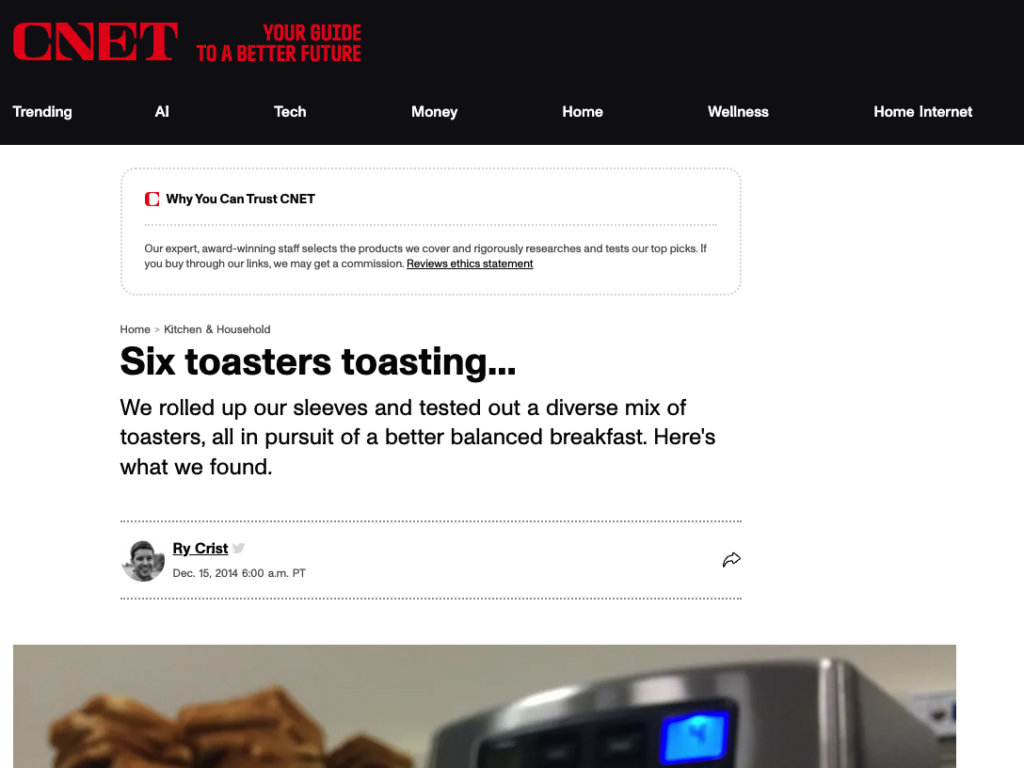
Check out WeEarnMedia’s podcast interview with journalist Miranda Marquit. She talks about this very problem around 15:34.
Both of these point to fewer journalists with less time being pitched by a growing number of link builders turning to digital PR as an outreach tactic.
But don’t worry. There is hope for us yet.
How to Be Effective in 2024
So, to remain effective with digital PR in a crowded space, here is some tactical advice:
Don’t go as big as you think. I recommend finding local angles or industries and beats that receive little exposure.
For example, instead of creating content about how AI will impact the fashion industry, write about how it will impact dog breeders or salmon hatcheries.
In the states, instead of looking nationally or even statewide, try local campaigns. Many local news sites don’t receive nearly as much love as their larger parent stations.
(You can see loads of examples of digital PR campaigns.)
Catch trends before they peak. Mark Rofe from DigitalPRCourse.com shared a screenshot of what a journalist’s inbox looks like after the Bank of England announced new interest rates. (Thanks to Laura Purkess and Mark for the screenshot!)
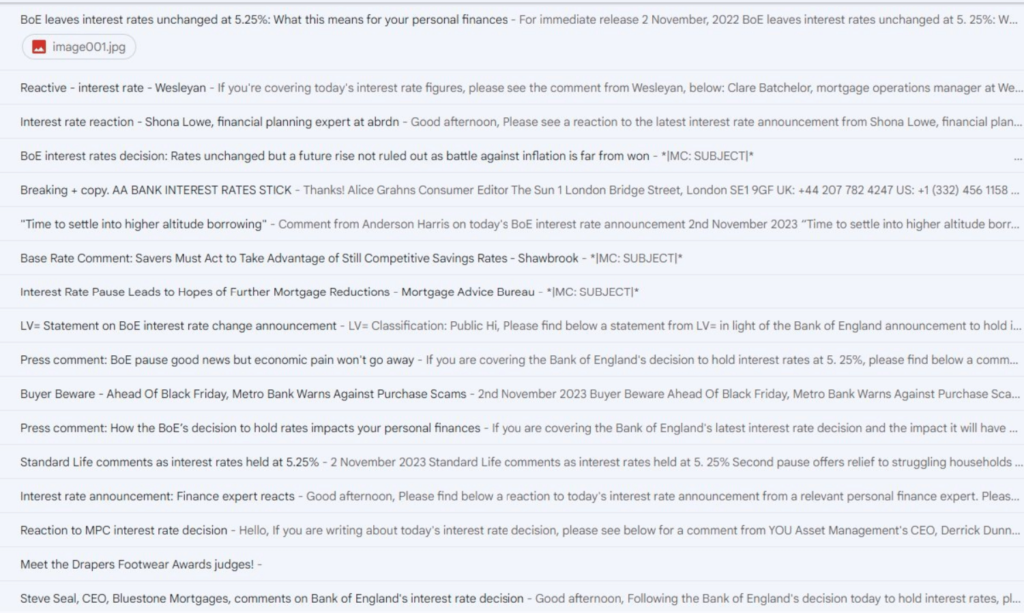
You can use tools like Exploding Topics to track a trending topic weeks and sometimes months before it reaches its peak.
Pitch narrowly and highly targeted emails. The more broadly you pitch, the more likely your pitch will be ignored—sometimes even closing doors with journalists that you wished remained open in the future.
All it takes is one journalist to click SPAM on an email; you can never email them again.
I wrote a post about building a media list from scratch without buying from one of the major tools.
Instead of working blindly off of a media list, curate that list and make sure the journalist:
- Is still active
- Still writes for the same beat
- Hasn’t written about the same topic recently
I could go on and on with tips like these (and I do weekly in our BuzzStream newsletter: subscribe today.)
3. Content-led Blogger Outreach
TL:DR: It doesn’t work as much these days unless you want to pay.
Content-led blogger outreach was my go-to strategy with Siege Media around 7-8 years ago. We would create content with a shareable asset, like an infographic, and reach out to relevant bloggers interested in sharing it.
Blogger outreach worked at about a 60% placement rate during the years I was doing it.
You could pitch an infographic or beautifully designed printable and get free coverage.
For instance, years ago, we created this fun infographic about how wind turbines work, and it got placements with eco-minded bloggers.
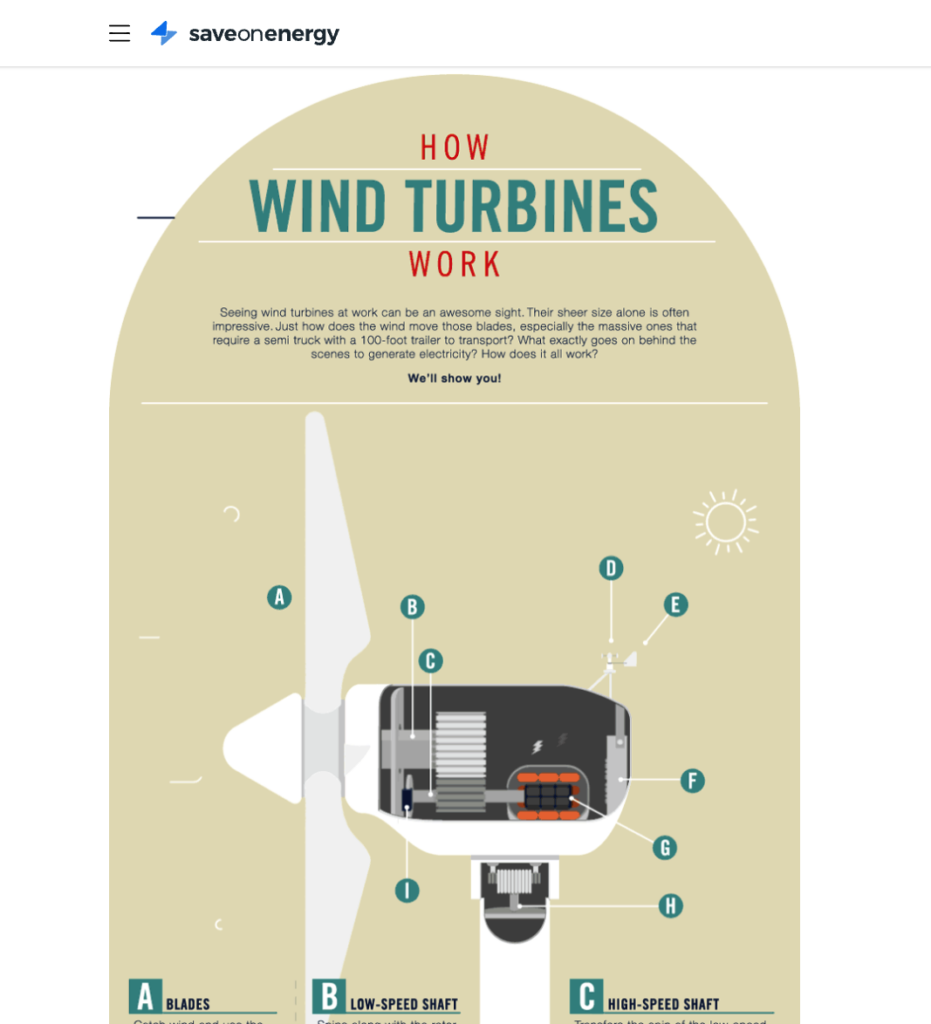
The line between blogger and publisher became blurry sometime after 2017 as more bloggers switched to monetization.
Fast forward to 2023, and I was getting a 10~15% placement rate with blogger outreach for the same type of infographics if I didn’t pay for placements.
Does It Still Work?
In theory, the number of bloggers negatively impacted by Helpful Content should be low, given that it pushes writers to provide real experiences and original content.
So, a travel blogger showing photos of their trip to Japan and displaying their experience while giving trip advice should be rewarded.
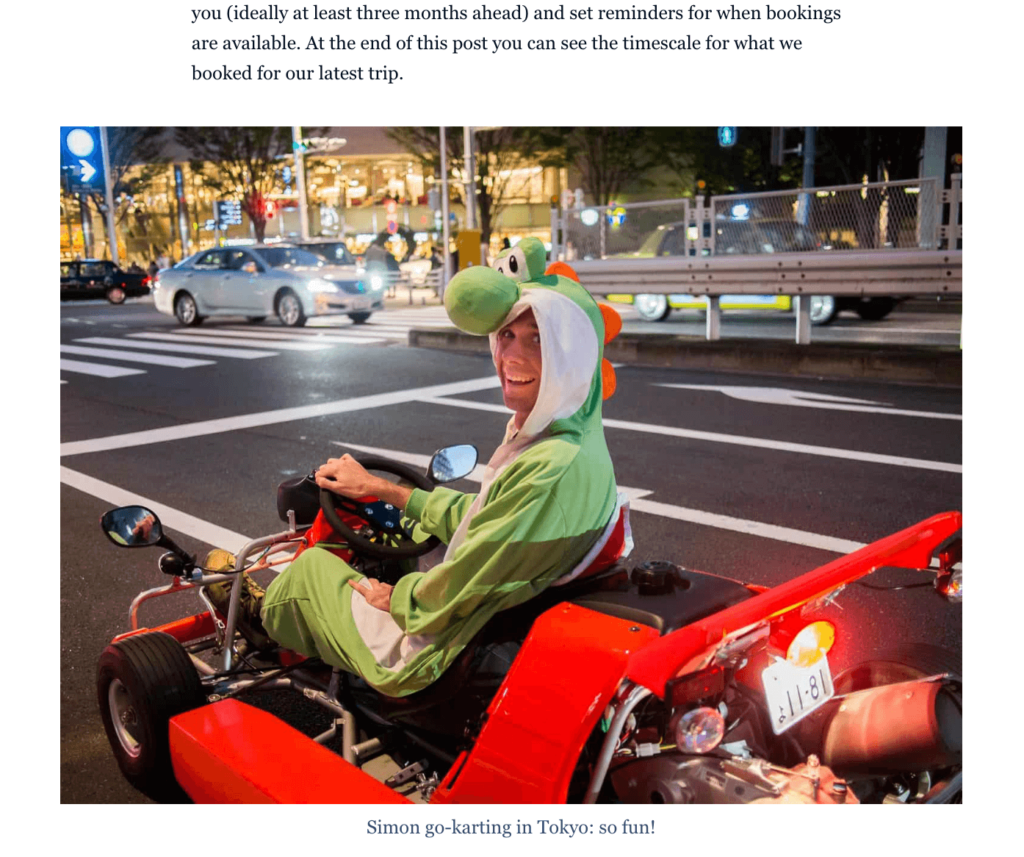
This means that the audience for blogger outreach should still be there.
But as I mentioned, the blogger industry has become extremely monetized. Finding bloggers open to sharing any asset without wanting money is extremely difficult.
If you get placement after paying, bloggers are technically supposed to tag your links as rel=sponsored and nofollow, which won’t drive any SEO value.
The nofollow renders the backlink virtually useless for its SEO value, which is what any link vendor or guest post site is selling you on.
But, since virtually no one marks guest post link placements as advertising, they are all at risk of being devalued by Google at any time.
How to Be Effective in 2024
Many heavily monetized industries like the ones below will face an uphill battle when trying to do content-led blogger outreach:
- Fashion
- Beauty
- Travel
- Personal Finance
- Fitness
- Food
- Parenting
You may have to pay to play.
The important thing is to still assess the site for “helpful content.” The name of the game is quality links — don’t just assume that Google will like it because it is a blog.
If you pay for placement, remember that you are the company you keep. If you are paying for links, chances are anyone can buy them. The more unnatural links featured on a site, the more likely Google will recognize and devalue them.
4. Broken Link Creation and Outreach (Broken link building)
TL:DR: Still works, but can be time-consuming and you get lower value links on average
Broken link building is one of the best, purely strategic link building plays available.
The strategy has remained fairly unchanged since its inception.
The strategy is to find content with many broken links and create something similar but better. Then, contact all the pages where the broken link appears and ask them if they want to replace it.
For instance, if I used Ahrefs’ Content Explorer tool, I would find a broken post about “digital marketing tips.”
Some of the highlighted pages below would work:
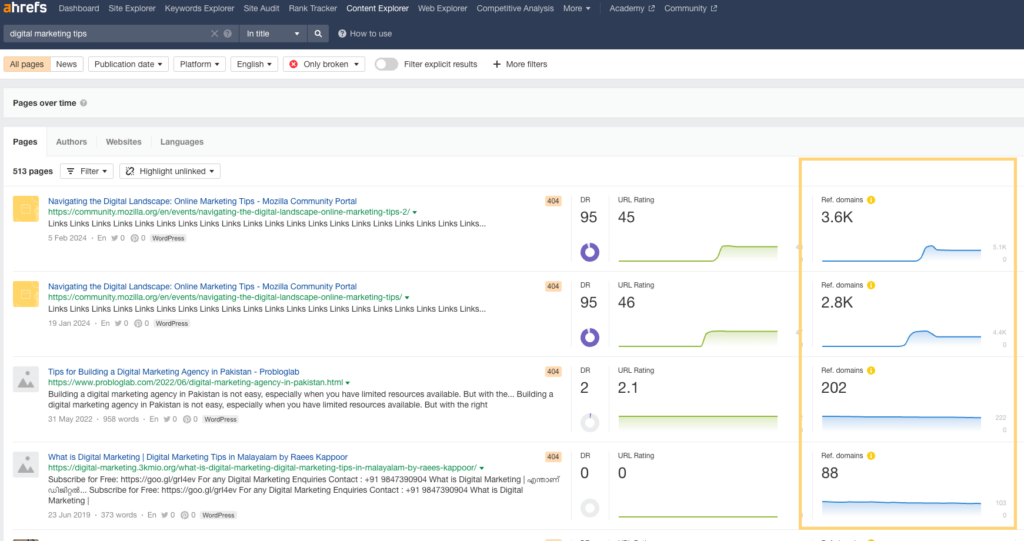
Then, I would use Internet Archive to find screenshots of the pages (remember, since they are broken, we can’t see them live) to determine which I’d like to recreate and improve upon.
All the sites that linked to the original broken page would become my outreach list.
Broken link building can get links from high-DA sites like .edu or .org. Although less likely, you can get links within content, sometimes on high-DA sites, and even from news publications like the New York Times.
Does It Still Work?
Yes, this can still work, but finding opportunities that fit your niche can be much harder.
SEO-savvy sites will most likely have their broken links covered. So, many of your higher DA opportunities with valuable links are taken.
How to Be Effective in 2024
This approach benefits you because you can determine the quality of the backlinks before you create your content. If the quality is low, then it’s not worth the time.
At a macro level, broken link building is an opportunistic strategy that rarely accounts for more than 25% of the strategies I’ve built for clients.
Not every industry or site has valuable content with broken links worth building.
So, use it to support your link building strategy rather than fully rely on it for results.
5. Creating Content to Build Links Passively
TL:DR: Works well; SGE may take some opportunities away.
Working at an agency, I had to build monthly links for my clients. At some point, I realized that quality, relevant links to posts I created came from sites I had never pitched.
So, I achieved our monthly goals and then some without lifting a finger.
This beautiful feeling came from a construction statistics post.
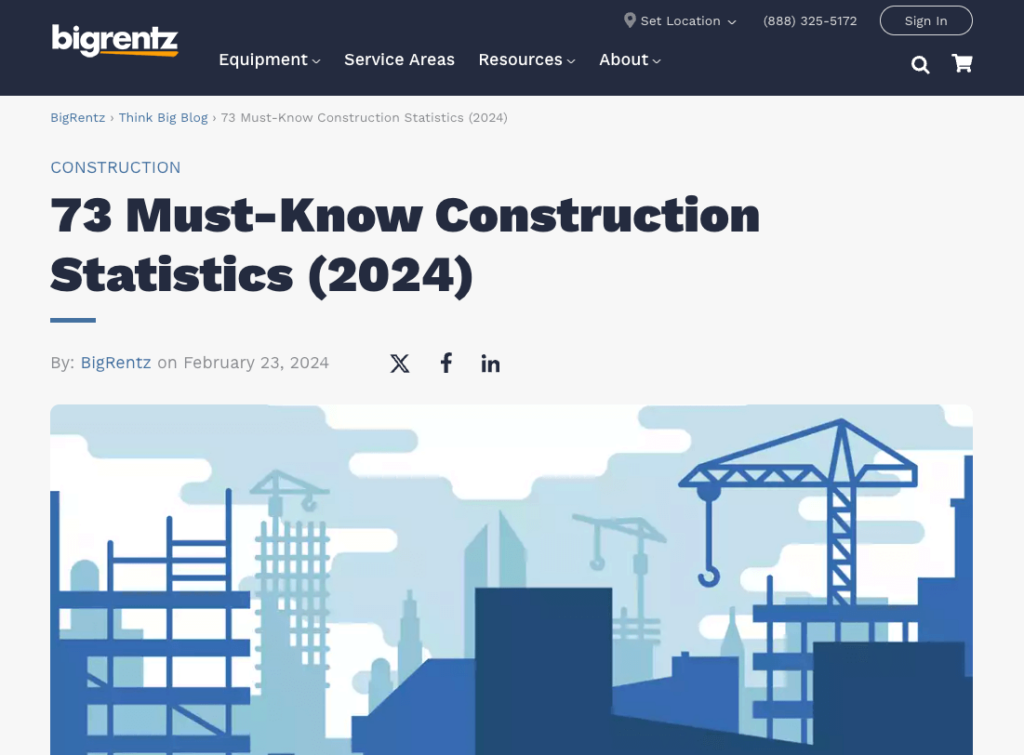
To build links passively, find a topic with high link intent and search volume, and it can build links naturally over time. You need your post to rank well before it can gain links.
But once it does, it starts a nice flywheel: Your position increases as you generate more links, which helps you rank better, and so on. (Remember this; it will come up again.)
The most obvious examples of this approach are statistics posts.
Unfortunately, it felt like around 2018, everyone in the SEO world simultaneously found this out.
I started to see sites rolling out entire content marketing strategies comprised of only statistics posts.
Business Of Apps comes to mind. Check out the screenshot of some of their top posts, there are ten statistic posts in the top 20 posts alone.)
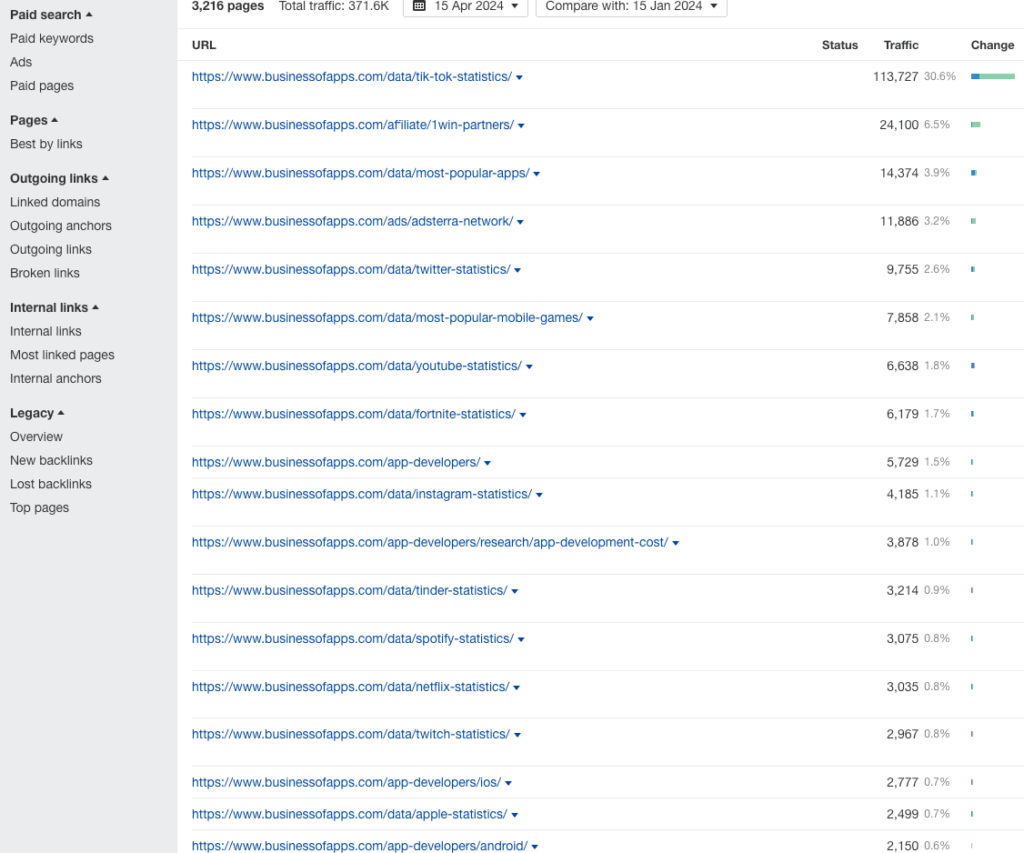
Back in the day, if you Googled a keyword + statistics, there used to be one or two ranking posts. Now, there are at least 5-6 on average.
This is still widely used in 2024. I’m getting emails from agencies offering statistics post link building services.
Not all link intent posts are statistics, but these are the most obvious, scalable approach.
The idea is to find topics researchers or journalists will search for when writing content. I saw this approach work firsthand with tools like Betterpet’s dog age calculator.
It’s a shareable tool that also has search volume for the keyword “dog age calculator”.
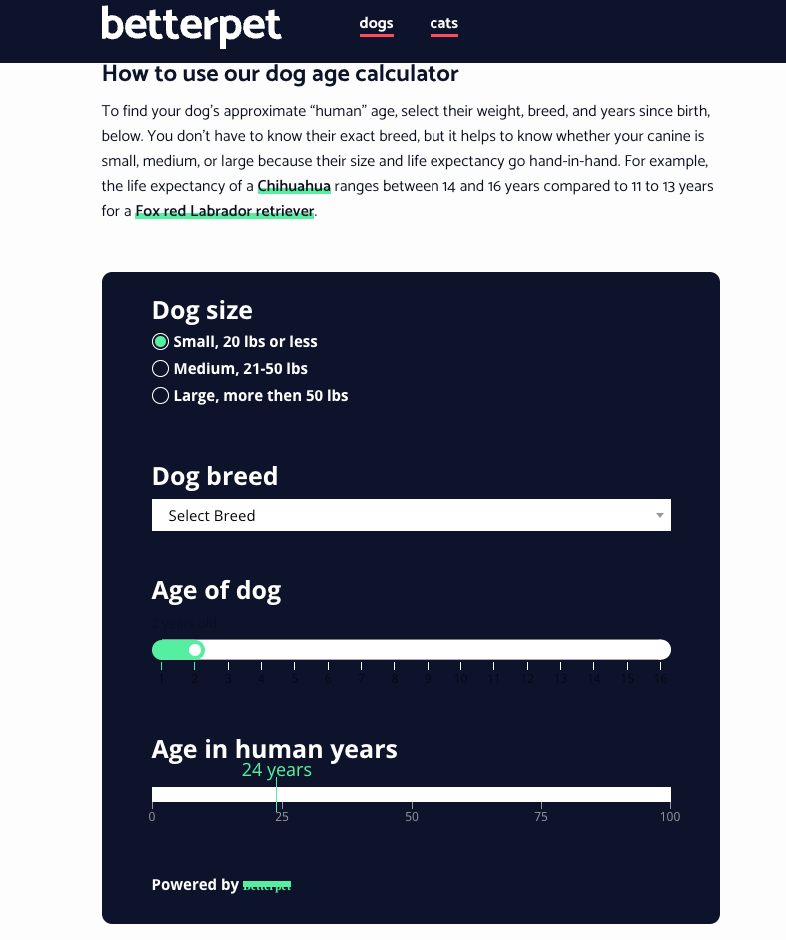
Or definitional queries. For instance, one of the first posts I wrote for BuzzStream on link relevancy recently gained its first link after ranking number one.
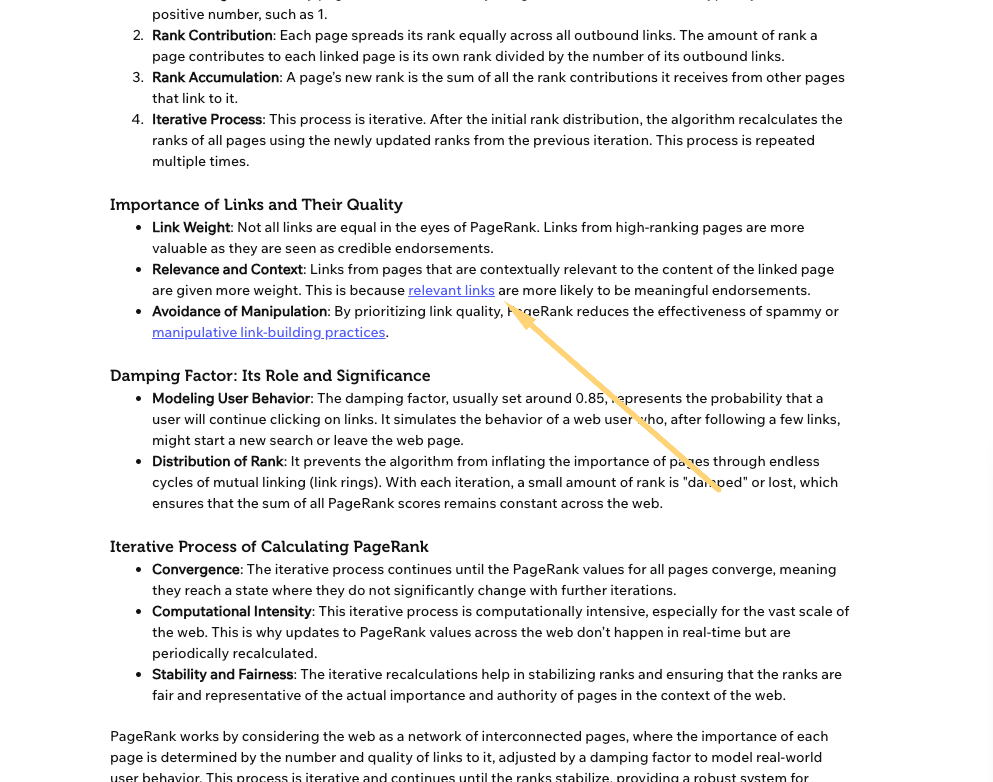
But wait, Vince. Why is this tactic in this post’s “creating and pitching” section?
Great question – I’ll get to that next.
Does It Still Work?
Yes, this approach works today. Helpful Content hasn’t impacted this approach at all. If anything, Google’s push for users to provide well-researched, well-cited information helps prove the need for this type of research.
But outreach may be needed.
Record scratch!
Let’s back up.
Three things are working against this approach:
1. Off-page research with AI – With the introduction of ChatGPT, Gemini, Perplexity, and other similar tools, researchers may go off-web to find sources. At the time of writing, none of these apps display proper sources.
So, if a blogger were to use ChatGPT to find “email marketing statistics,” they may not source their post, even if ChatGPT got its information from it.
2. Oversaturation and higher competition – As more users like BusinessofApps.com have gotten involved in the passive link building approach, the competition has increased.
Remember the flywheel? Competition makes it harder to rank for a keyword. The harder it is to rank, the less likely you will gain passive links from this approach.
This leads me to the last note.
3. Outreach may be needed – When I was with Siege Media, we found that brands could rank for these keywords based on the strength of their domain (DA or DR), and no outreach was necessary.
Fast-forward to now, and I’m finding it increasingly difficult for brands to do this without using some outreach.
How to Be Effective in 2024
You may need to get some links to jumpstart the process to remain effective.
Again, passive link building only works if you can get your post ranking. So, an effective approach would be to create a linkable angle to your post or linkable asset.
For instance, the construction statistics post I mentioned had an infographic we could use to pitch the post.
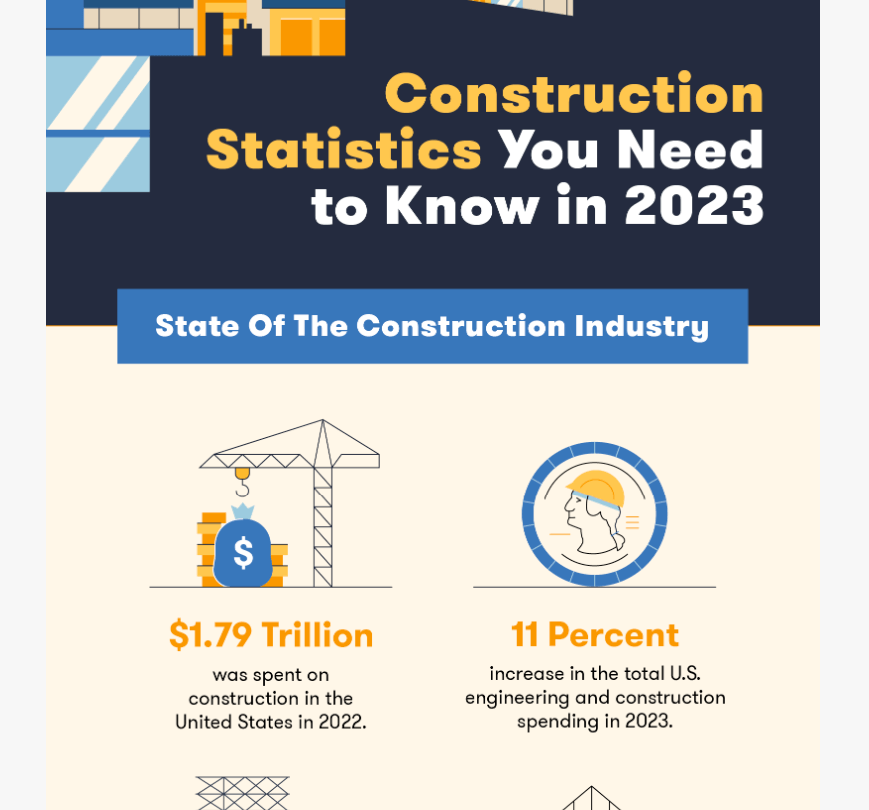
We didn’t realize it then, but we were jumpstarting the process of passive link building.
You can see the initial ~10 links we built in the link velocity. A few dropped off, and then the link gained steam itself.
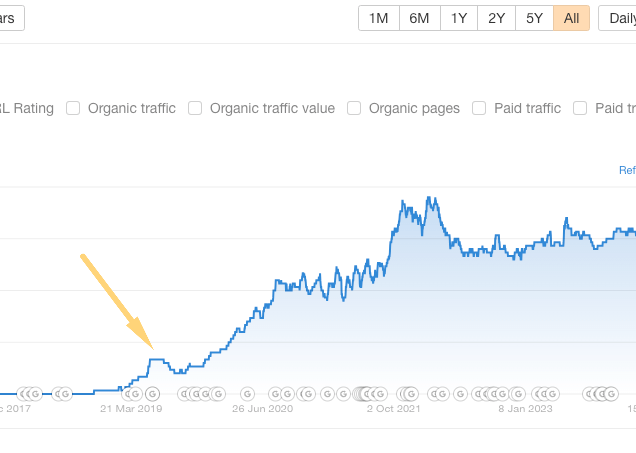
Is outreach necessary for all passive link approaches? Not necessarily.
If you’re a new site, or the keyword you are going for has a lot of backlinks, then this is where you’d need to accelerate the process.
Even if there is little competition, promoting your content for links is never bad!
Pitching Content Using BuzzStream
BuzzStream aims to help you send personalized emails at scale to get backlinks. Since we already have a lot of content on this, I’ll instead send you to the proper pages:
- Here is a run-down on how to build your own media list.
- Here is how to create a media pitch for digital PR pieces.
- Here are email templates to use for your outreach.
Pitching Yourself as a Thought Leader for Links
Any way you can position yourself, your site, or your client as a thought leader can get you links and exposure.
There are four main tactics for this strategy:
- Guest Posting
- Proactive and Reactive Quote Pitching
- Responding to HARO/Qwoted requests
- Podcast Outreach
6. Guest Posting
TL:DR: Works but heavily monetized. It’s very important to evaluate the quality (especially when paying)
Guest posting is one of the most widely used link building strategies. You find a relevant site in your industry and pitch yourself to be included as a guest author.
It helps build authority and visibility and can get backlinks.
However, guest posting has become one of the most exploited strategies.
Millions of sites have been created solely to sell link placements. We analyzed guest posting sites and found that of the 800+ top-ranking posts on their lists, only about 150 were quality sites.
Google has made many attempts and announcements to curb the practice of scaling link building using guest posts.
Today, do a Google search for “guest post,” and you’ll see sites offering guest post placements for as low as $4.99 per link. (Don’t ever buy these.)
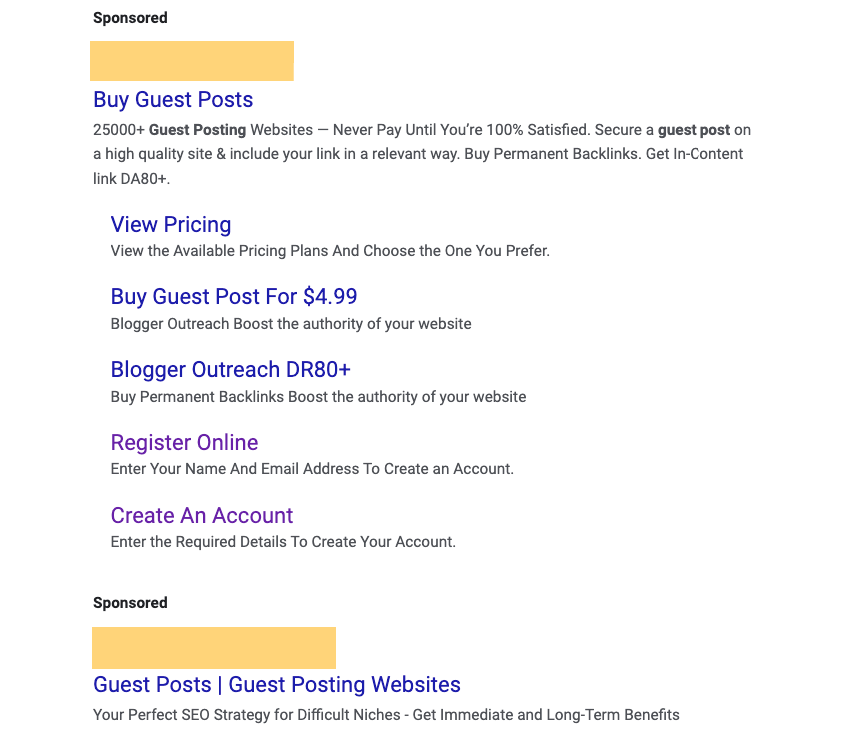
Similar to what I mentioned with blogger outreach, the main risk is that paid placements are technically supposed to include a rel=nofollow and sponsored tag.
The nofollow makes these relatively useless for SEO, so many ignore them, putting them at risk of being devalued.
(Watch this SEO Office Hours episode with John Mueller for great insight into how Google views guest posting.)
Does It Still Work?
From a Google standpoint, there isn’t anything wrong with using it to promote your brand or establish yourself as a thought leader in the industry through guest posting.
However, as a pure link-building tactic, the risk factor increased tenfold after introducing Helpful Content.
One of the main kinds of sites that Google is trying to get rid of on the web is those that are lazily built to exploit SEO loopholes.
You’ll find that most sites appearing on “guest post” lists do just that.
They either advertise paid guest post placements, accept any and all guest posts, or make no effort to maintain the site’s quality.
Here’s a peek at a site whose traffic has tanked during the Helpful Content updates starting in 2023.
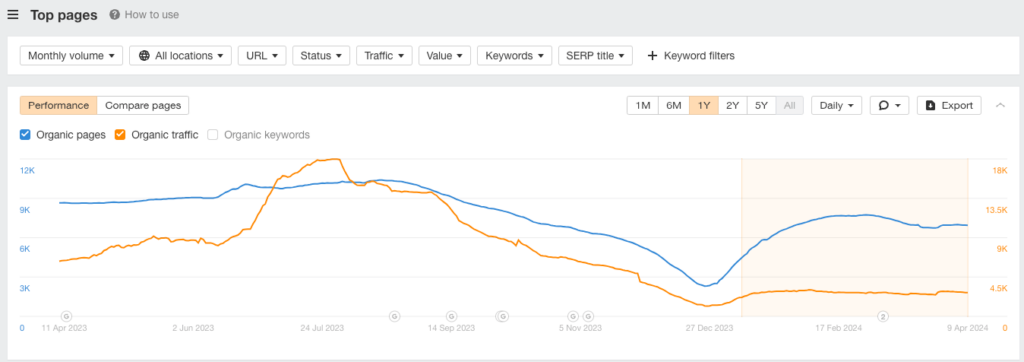
Chances are Google has devalued the links from most, if not all, of the sites that charge for guest post placement.
Since 2022, they announced they have been using machine learning (called SpamBrain) to weed out spammy sites that do buying and selling of links for ranking purposes.
Plus, those guest post Google Sheets you see out there? Google sees them and most likely takes action on those sites to devalue them, as it has in the past during Google Penguin.
Again, they aren’t penalizing the site. Instead, the links you acquire from them are not worth anything.
Barry Schwartz outlines how it worked after Google Penguin in 2016, so you can assume they have also become much more sophisticated.
How to Be Effective in 2024
Consider guest posting as a brand-building exercise to be successful with a link-building strategy after the Helpful Content updates.
Rather than asking and looking for brands to get a link from, think about what brands you want your brand name associated with.
The more you think about guest posting from a brand perspective, the more you will naturally associate yourself with quality, relevant sites and weed out the spammy guest post sites.
You’ll also spend a lot less time sending irrelevant emails because you’ll focus less on the quantity and more on the quality of your placements.
7. Proactive and Reactive Quote Pitching
TL:DR: Works great for links, though journalists are slammed these days.
Pitching quotes via HARO (something I’ll talk about in the next section) was one of the first things I learned about in link building.
However, proactive and reactive quotes pitching directly to journalists without platforms like HARO don’t get discussed outside of the digital PR landscape.
(I looked at the top 10 ranking posts for “link building strategies,” and none even mentioned it. )
Link builders with a pulse of the news and a solid workflow for producing and pitching quotes from thought leaders can consistently generate high-end news links.
A great example of proactive quote pitching is when you know a major calendar event, study, or data release will happen in your industry.
For example, the US Federal Reserve changes the Fed Funds Rate eight times per year based on a predetermined schedule.
Each time, there is a chance to prepare a quote to pitch.
Another example is that at the time of writing this article, a major Solar Eclipse was occurring worldwide.
Journalists covered the event constantly leading up to it and needed expert quotes to support their articles.
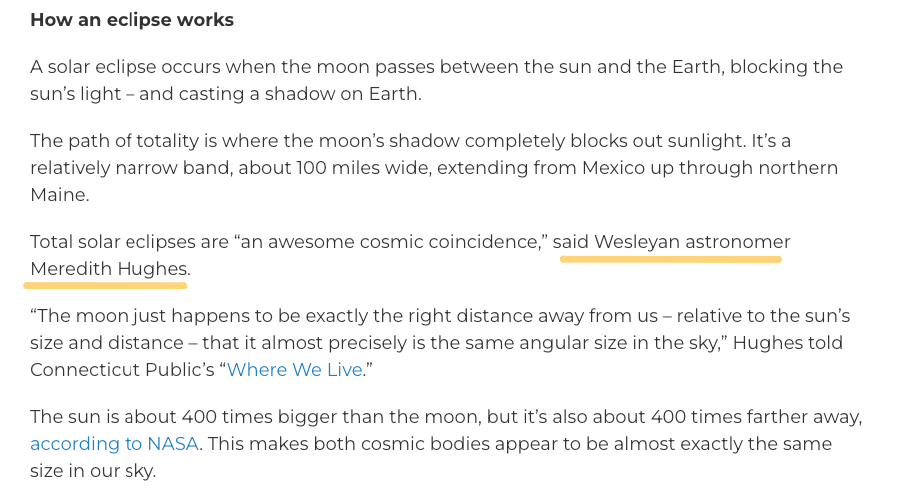
Reactive pitching is when you pitch a quote commenting on a major news event, like an earthquake, market crash, or celebrity death.
For example, after an earthquake near where I live on the east coast of the US, local reporters scrambled to tell stories and get expert opinions and insights.
You can see one below:
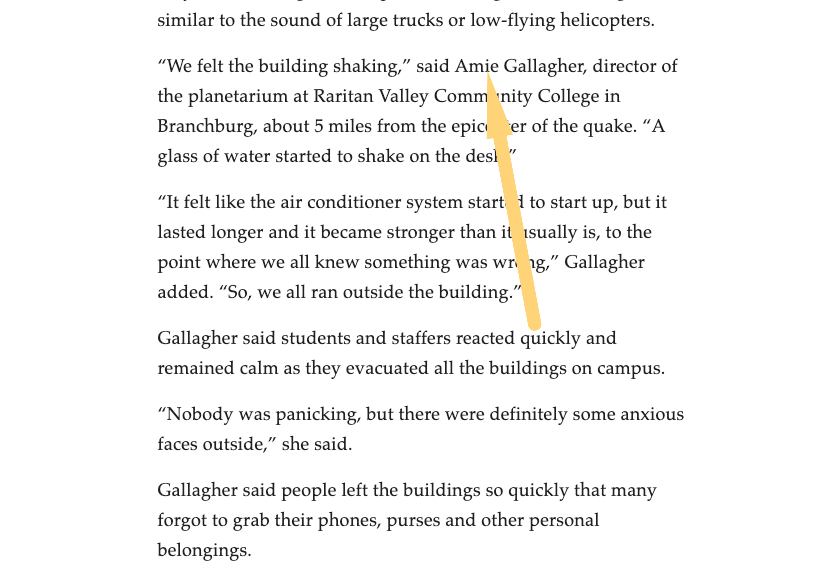
These types of stories require quick thinking and pitching but can yield great results.
Does It Still Work?
Everything about this tactic works well post-Helpful Content.
There is nothing inherently spammy about this tactic (unless you spam the journalist — something I’ll get to in a bit).
Quotes from experts strengthen articles and help display expertise (one of the E’s in Google’s E-E-A-T).
One downside with quote pitching is that the market is saturated with them. It can sometimes be hard to cut through the noise.
(Remember the image of journalist Laura Purkess’ inbox after a major news event?)

Plus, as I mentioned when talking about digital PR, journalists are experiencing massive layoffs around the world.
With fewer journalists and more PRs, you must ensure your pitch is laser-focused on the right journalists.
Also, make sure you are pitching the best opportunities.
One of our podcast guests, Mark Rofe, owner of DigitalPRCourse.com, explained a tactic he likes to use: he breaks down quote pitching into four quadrants: unplanned vs. planned pitching, low interest, and high interest.
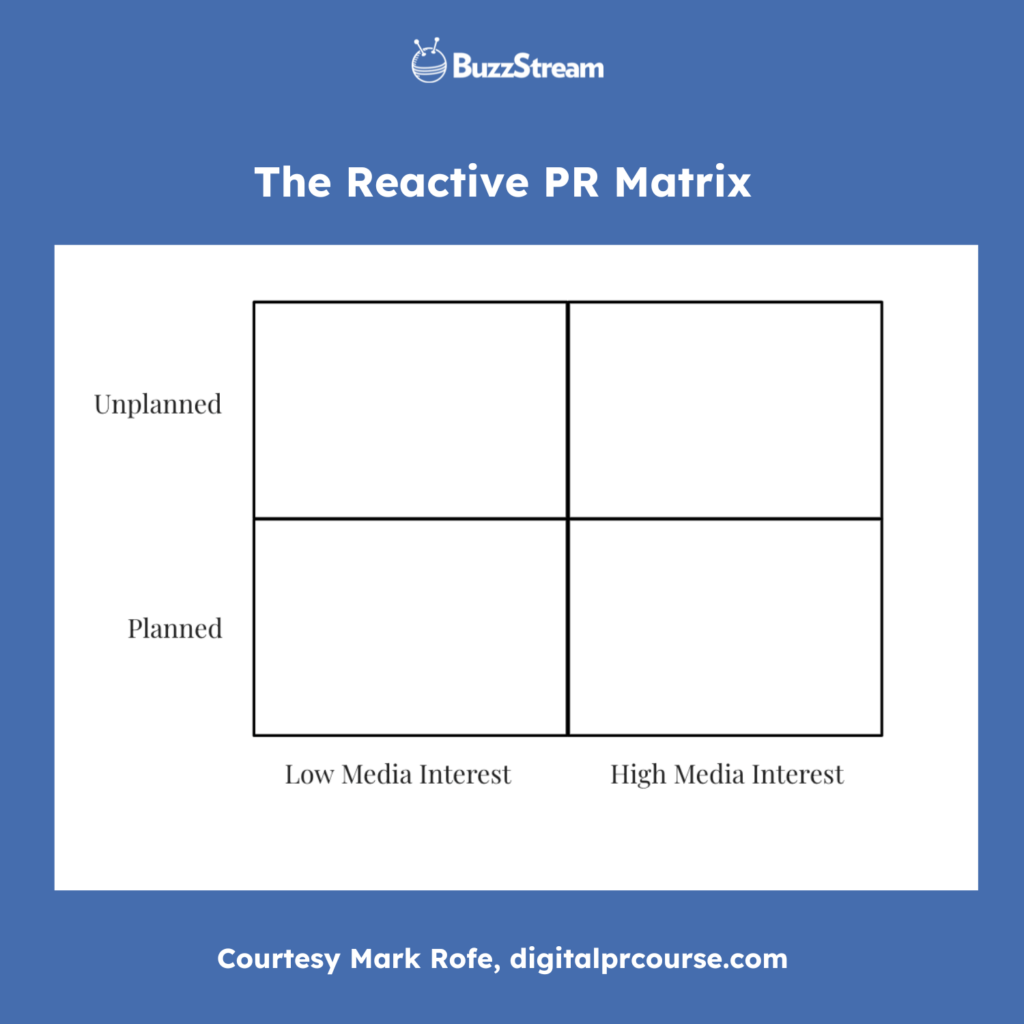
Mark recommends focusing on high-interest, unplanned opportunities because they will have the least competition.
So, if you are an expert in the finance sector, wait until the perfect unplanned event instead of pitching quotes around all the finance events.
The perfect event is high-interest in your industry.
Do a Google News search to understand what events in your niche get coverage.
You can then set up some Google Alerts to ping you whenever something major occurs around those keywords.
Then, you can even pre-write quotes based on major events that may happen in the industry.
For example, in finance, markets will ebb and flow. Set up alerts for keywords like “recession” or “market crash.” (Dark, I know, but this is news!)
Have some quotes ready for the high highs and low lows.
If you can’t pre-write quotes, at least establish quick communication with the person who needs to prepare them.
Mark even recommended having the cell phone numbers of your stakeholders so that you can quickly text them in case of an emergency quote.
8. Responding to HARO/Qwoted Requests
TL:DR: Works but is noisy and crowded. I prefer HARO competitors like Qwoted.
When HARO (Help a Reporter Out)—now called Connectively—started years ago, it was a major link-building strategy. Today, many link-building and digital PR agencies offer this service because it still works.
A journalist or blogger uses the platform to request a specific quote from a thought leader or expert. Then, users (like link builders and PRs) submit quotes for the journalists to use in their articles.
Because many journalists use the platform, it yields high authority and, if used correctly, highly relevant links.
I used it with Homebuyer.com almost every day to help get links. Dan Green, the Founder and CEO, still gets placements.
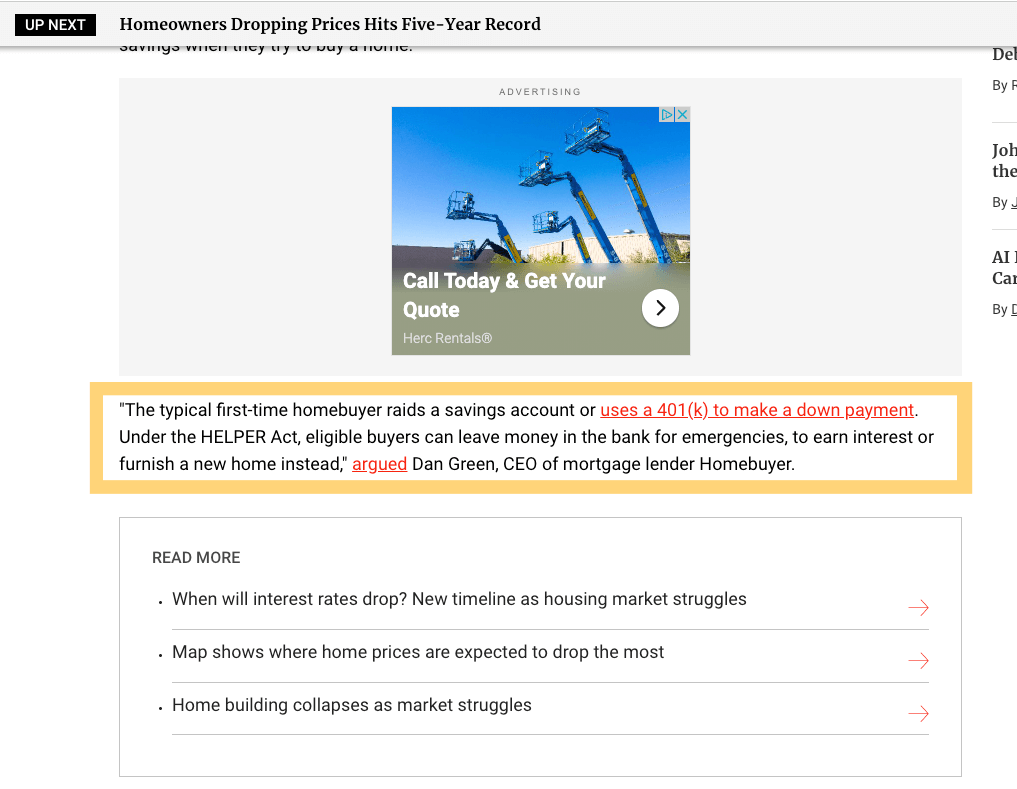
Given the great need for this type of content among journalists and bloggers, many other copycat services have been launched since HARO first emerged.
Some are great, like Qwoted or Featured. They offer more customization for setting up the kinds and frequency of quote requests you can get.
Many in the UK use a popular #journorequest hashtag on X to reach journalists.
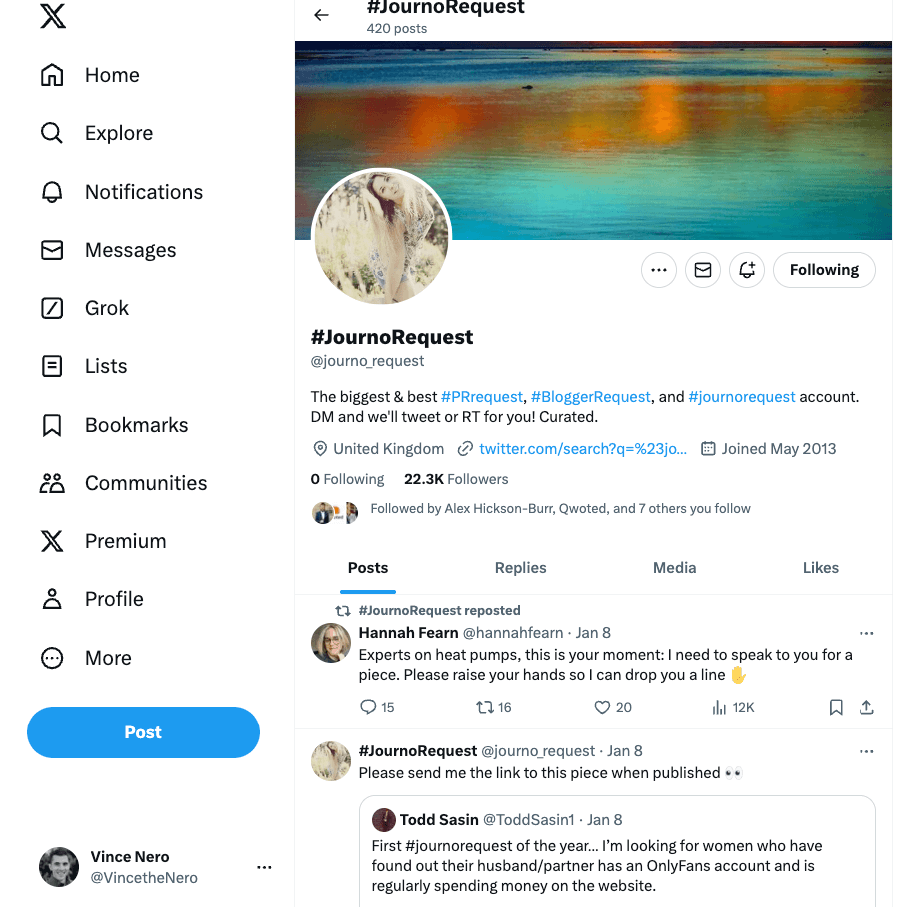
The fact that so many platforms exist for this purpose suggests that this is still a viable link building strategy.
We have an entire guide on gaining coverage with journalist requests.
Does It Still Work?
Responding to journalist requests via the platform works great post-Helpful Content, for the same reason the previous tactic of quote pitching directly to journalists works: providing expertise and authority.
If journalists or bloggers are looking for thought leaders, and you (or your client/site) can be that thought leader, it’s a win-win for both parties.
However, the major downside to these platforms comes from Gary Vaynerchuk: “Marketers ruin everything.”
Users spam journalist requests like you wouldn’t believe. (People have created AI-bots that auto-answer queries.)
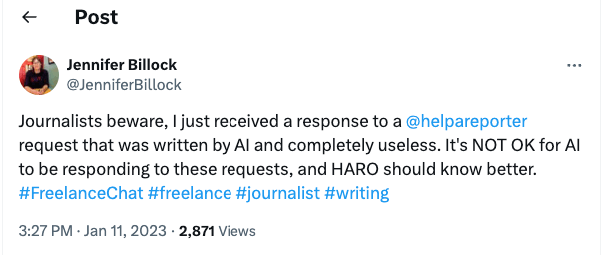
So, the problem isn’t if the link opportunities are there; it’s if the journalist or blogger requesting the quote will read (or even see) your answer.
How to Be Effective in 2024
To stick out, Dan Green from Homebuyer.com recommends that you “Answer only what the journalist asks for. Keep your pitch short and sweet. Journalists are looking for a one or two-sentence quote, not an essay.”
And remember, if you are not exactly what they are asking for, don’t pitch.
For example, if the request is for dog trainers and you are a site that sells pet products, you shouldn’t pitch.
Last, you need to respond as quickly as possible. Journalists are on deadlines.
One study from Redline found that the best conversion rates on HARO requests came when the response time was under 6 hours.
9. Podcast Outreach
TL:DR: Works for links, but there is a limited supply
Appearing as a guest on a podcast is one of the best ways to establish yourself or your client as a thought leader in the industry.
And with over 4 million podcasts out there, according to Podcast Index, that’s a lot of opportunity.
Most, if not all, have some sort of website or blog where they promote the podcast.
For example, when I got the job at BuzzStream, the first thing I did was start pitching myself on podcasts. This yielded appearances on podcasts like Optimize, We Earn Media, and Create Like the Greats.
(Fun fact: I wasn’t linked at first, so I contacted the podcaster and politely asked if they could add a link to their page. They obliged:)
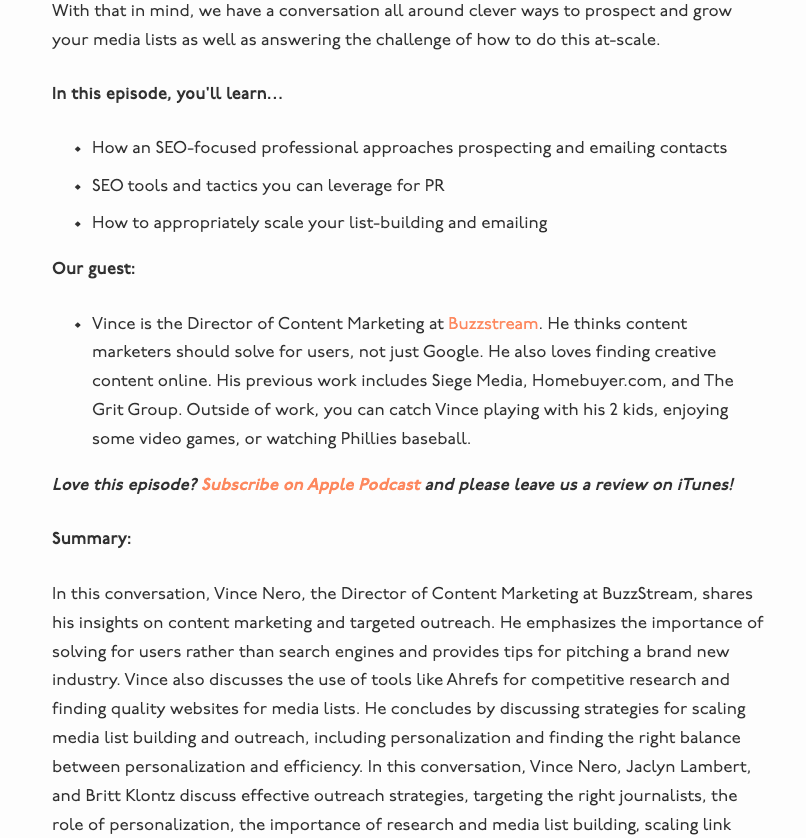
So, pitching yourself as a guest on a podcast using “podcast outreach” for links is a no-brainer.
Does It Still Work?
Pitching yourself on podcasts still works as a link building strategy. The recent updates haven’t impacted this strategy at all.
The only potential downside is that it’s not as scalable — especially in an industry with few podcasts.
But podcasts can have a lot more upside than just links. Most are shared extensively on social media, which can bring direct traffic to your site.
They can also lead to bigger and better things, like guest posts or even speaking engagements.
How to Be Effective in 2024
To find podcasts in your niche that are looking for guests, you can use a tool like Podmatch.
However, I recommend really getting to know who the main podcasts are in your industry by searching for keywords on your favorite podcast platforms.
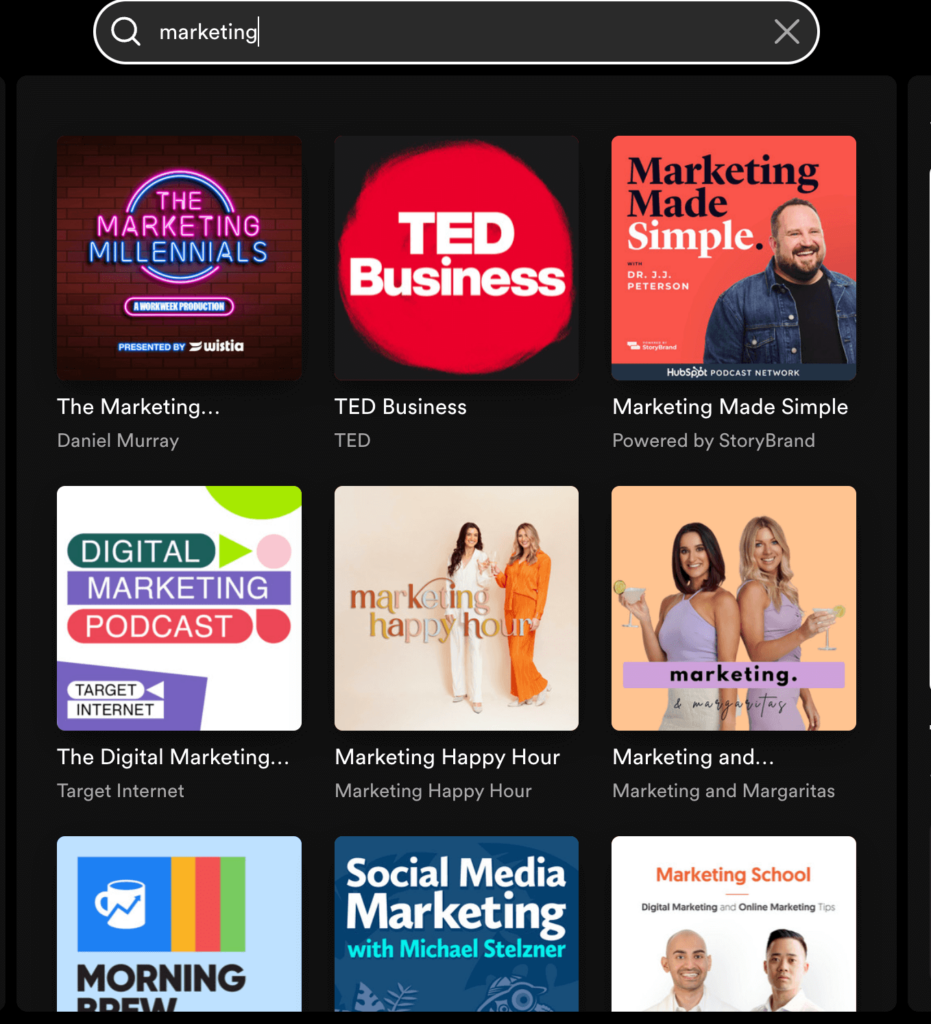
Then, strike up a conversation with the hosts before pitching yourself. Get on their radar, and let them know who you are.
After a while, you can ask if they have any guest openings. But make sure you have something unique to bring to the conversation because no one likes a boring guest 😉
(If you are reading between the lines, yes, this is how you could pitch yourself to be on the BuzzStream podcast — and I’ll even give you a link!)
Placing Links in Existing Helpful Content
Any strategy that gives you control over your link placement allows you to control the link quality.
The tactics used as part of this link building strategy are:
- Link insertion
- Resource page link building
- Broken link building
- Unlinked mentions
10. Link Insertion
TL:DR: Works but is heavily spammed. The focus needs to be on quality sites.
Link insertion is one of the more traditional link building tactics and is still widely used today. It involves finding existing content and asking if they will add your link.
For instance, pretend I found an instance of someone saying “digital PR tool” somewhere on their blog, but it wasn’t linked.
(I could use the search operator intext: “digital pr tool”)
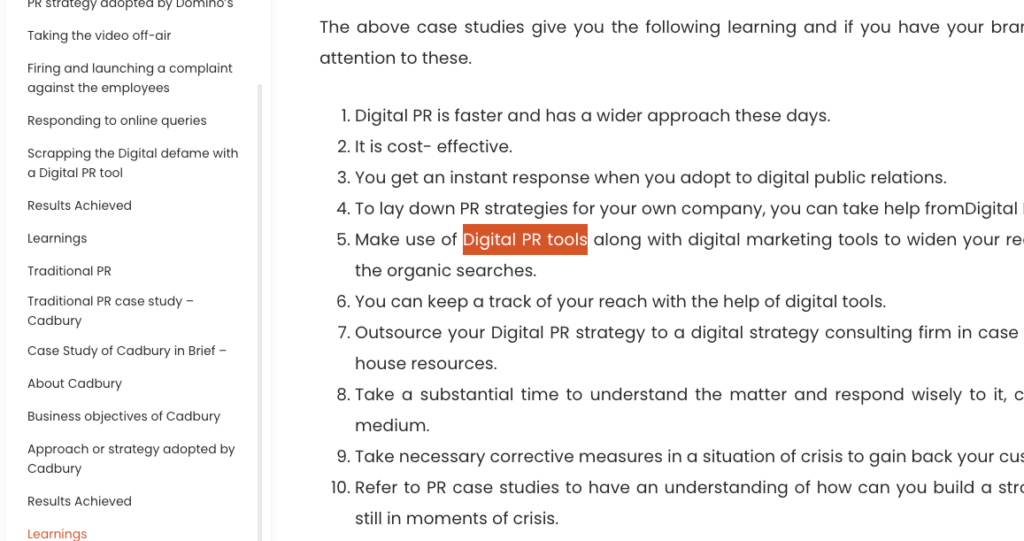
Then, I’d pitch them, asking if they’d be willing to add my link to their post to give their users more context.
Although it started as a clever strategy for generating links, link insertion has become highly spammed.
You probably notice a trend here, but the more something is spammed, the more users tune out unless money is involved.
So today, you’ll see hundreds of agencies offering their services and thousands of websites offering link insertions behind the scenes.
But watch out, link builders!
Some links can appear unnatural, and that’s where you’ll get into trouble.
Link insertion relies heavily on anchor text mentions. Google places a lot of value on the words used in the anchor text and the words surrounding your anchor text.
So, if the words surrounding the anchor text have nothing to do with it, then the link will be less valuable.
Does It Still Work?
It depends.
You must be very strategic about how and where you get your links. The recent Helpful Content Update has taken a big swing at low-quality content, removing 40% of the web’s spammy sites.
Plus, Google doesn’t like when users build links by “placing them.”
And it seems just to bug Google’s reps, which, to me, makes it even riskier. Look at this answer I got when asking about evaluating earned links:

And you might be asking, how would Google even know?
That’s a great question, and I’ll address it in the next section—it concerns anchor text.
How to Be Effective in 2024
First you need to evaluate your target page and site (something I talk about extensively in our helpful content post.)
But specifically for links, avoid excessive exact match keywords with your anchor text. You can get a lot of value out of surrounding words.
Also, you may want to consider avoiding excessive linking to product or service pages.
The main reason is because it’s just not natural.
For example, if you are looking to build a link to a link building services page, you don’t want the text to read, “link building services”.
It feels way more natural to link to a home page than a page deeper within your site.
Realistically, if someone mentions your brand naturally in a post, what are the odds that they will link to your product or service page rather than just your homepage?
So now you’re probably asking so, how do you get people to visit your product pages?
Another great question!
That is where UX and great SEO best practices come in. Ensure that users can flow to your products naturally from your homepage.
For instance, BuzzStream has a link that says “Get Started” in our navigation to get users to our pricing page — the most important part of our funnel.
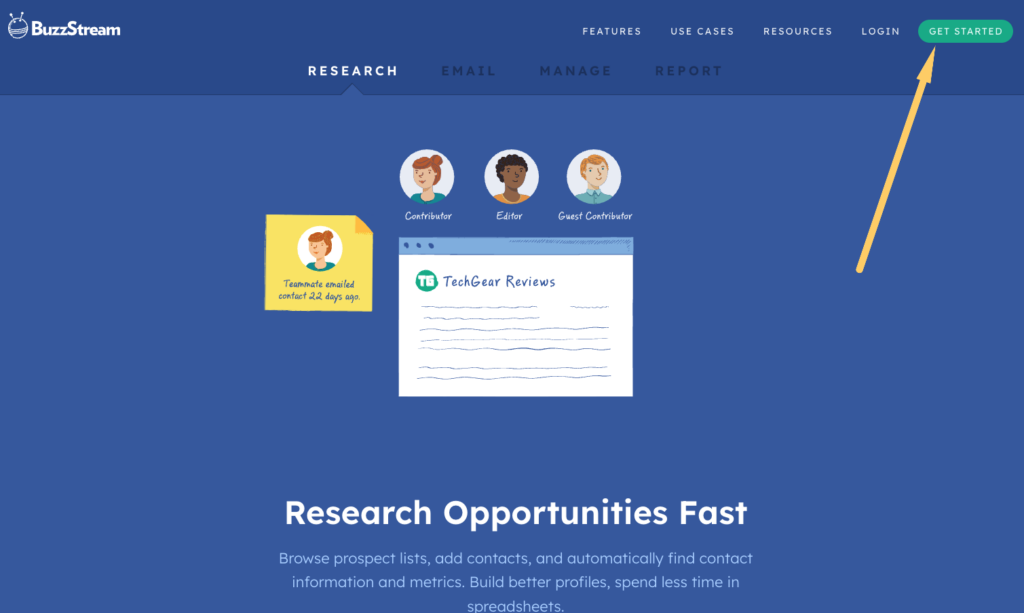
We also have links to our “feature” pages where users can learn more about our link building tools.
11. Unlinked Mentions
TL:DR: It still works really well. However, if you are a smaller brand, you are less likely to have opportunities.
Unlinked mentions work for any brand in any capacity.
You listen for mentions of your brand online using a tool like Google Alerts, Talkwalker, or Buzzsumo, and then reach out if a website mentions you without linking.
I have several alerts set up for BuzzStream.
I just came across one when drafting this post and fired off a request:
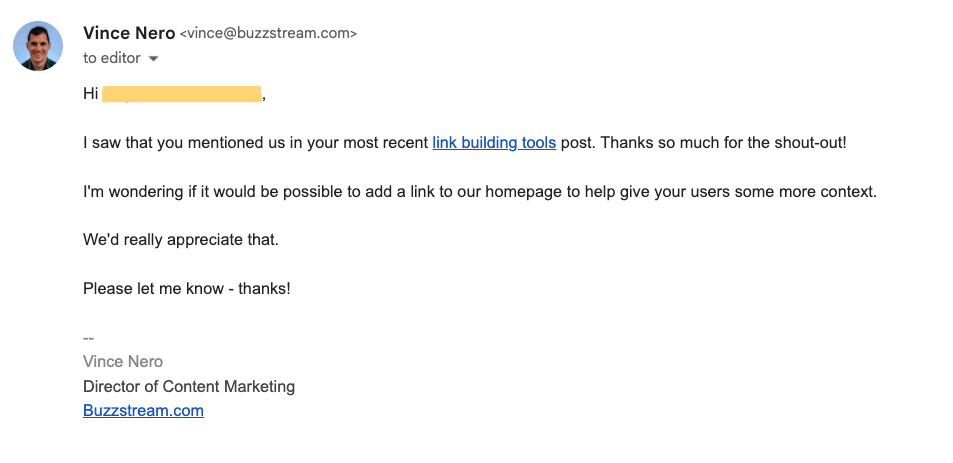
Most new brands won’t see much out of this exercise if they aren’t doing any brand building, whereas well-known brands who have been around for a long time likely see several per day.
This strategy of leveraging unlinked mentions for links has stayed pretty much the same for years.
Yet again, the only difference I’ve seen is that site owners often ask for money.
Am I saying that a blogger or website might mention your name with the idea that you will come looking for a link?
I don’t know of any agencies doing this outright, but the strategy exists.
Any directory site or review like Yelp OR BBB.org counts on you coming to them to “claim” your profile. And most of the time, you need to pay for it.
So, this strategy is not too far off.
It’s essentially ego bait, except you’re the bait this time! 🦈
Does It Still Work?
Yes, this still works.
This tactic is not spammy since the user already mentions your site. If anything, Google would most likely prefer the link to your site because it helps users better understand what your page is about.
Also, regardless of any algorithm update, the fact that bigger brands get more unlinked mentions from smaller brands is still true.
There are some ways to jump-start this cycle for smaller brands, which I’ll outline next.
How to Be Effective in 2024
Nothing has changed about this tactic, so the strategy is to ensure you have a good flow for finding unlinked mentions and then emailing quickly.
When I was with Siege Media, we found that if we didn’t respond to journalists to add a link in 24 hours, we’d never hear from them again.
So, make sure you have your brand alerts set up using Talkwalker. I’ve found Talkwalker to be more reliable than Google Alerts.
Then, set up your email template ahead of time so that you can send an email whenever something comes in.
12. Resource Page Link Building
TL:DR: Works but limited supply. Don’t assume .edu = high-quality.
Resource page link building is great for getting links on pages from higher authority sites like .edu or .org.
This tactic relies on you having a piece of internal content (typically “ultimate guide” posts or tools) that could be added to a list of resources. Some even use a homepage or microsite if it is truly a good resource.
Then, you’d search for a page that would be interested in adding your content.
For instance, BuzzStream has a tool called Meta Tag Extractor, built years ago.
If I wanted to build resource page links, I’d search for pages titled “link building resources.” If I found a page with a list of URLs, I’d pitch the site, asking if they’d consider adding our tool.
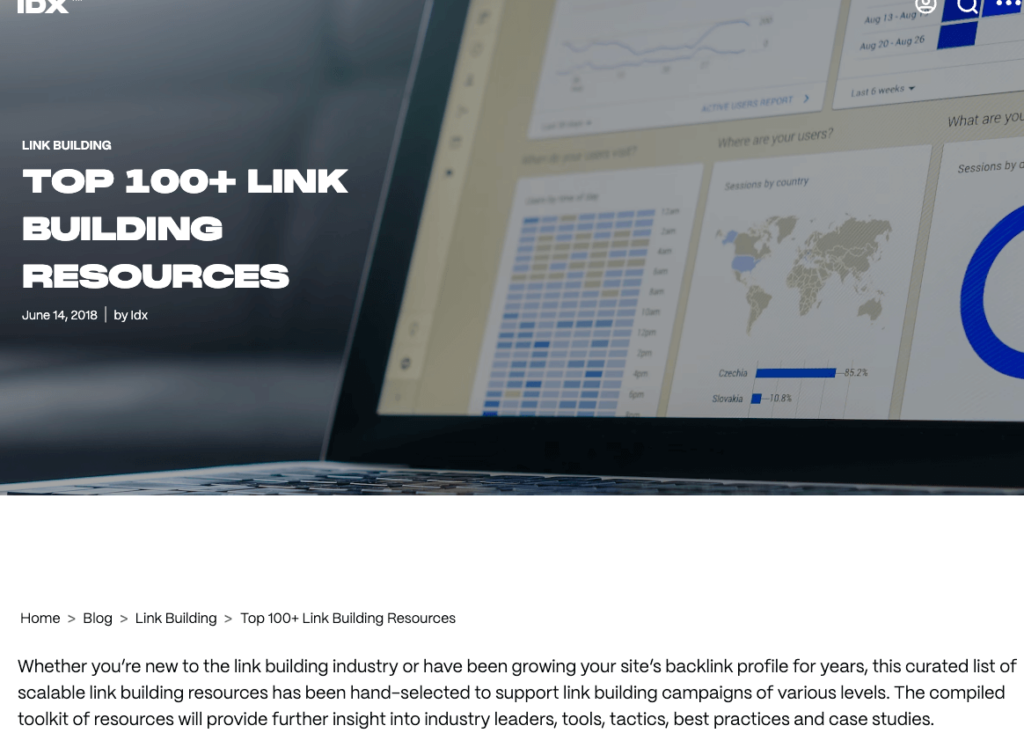
This approach has also remained relatively unchanged for years. But, like most on this list, it is a sound strategy that SEOs have spammed to death.
2015, I’d have to send about 200 emails to get ~10 links. But my last campaign in 2023 was 500 emails for the same results. (These are all personalized emails, not bulk sends.)
Does It Still Work?
Helpful Content updates have hit many low-quality sites, and resource page link building sometimes gets you into the dregs of the internet.
So, the same challenges remain as any other quality-based assessment.
If you’re willing to put in the time to find quality sites, you can still make resource page link building an effective tactic.
Another thing to consider is that not all .edu links are valuable. This isn’t unique to Helpful Content but has been around for a while.
In a since-deleted Tweet from Google’s John Mueller, he said:
“Because of the misconception that .edu links are more valuable, these sites get link-spammed quite a bit, and because of that, we ignore a ton of the links on those sites. Ideally, they should just nofollow all of those links instead of us having to ignore them.”
Put differently, just because a site has high DA doesn’t automatically mean the content is valuable.
Furthermore, when a site has a high DA, it doesn’t mean that every link from that site is valuable.
So, again, to truly get value out of this tactic, you need to assess the quality of the page and site before doing outreach.
How to Be Effective in 2024
With resource page link building there are qualitative assessments to make, as well as technical ones.
I’ll walk you through the most common ones that occur with resource page link building.
Let’s use this University of South Florida page as an example to walk you through it.
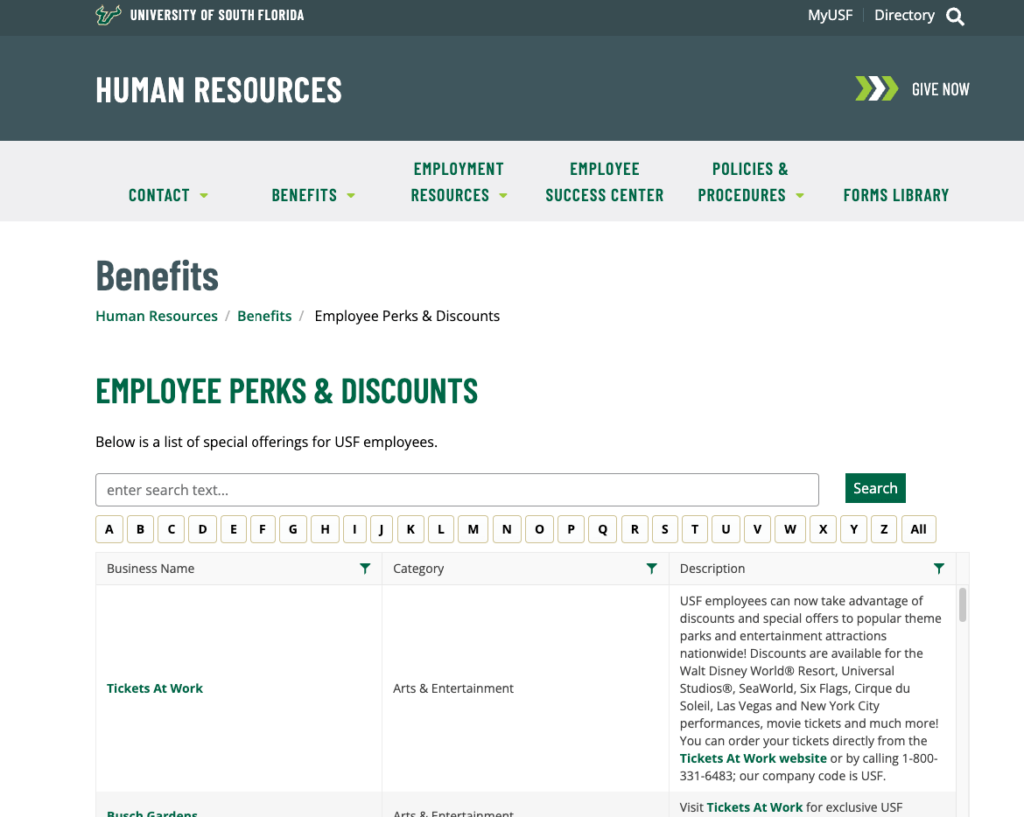
I’ve found a page on their site that we could use to pitch a resource.
First, we have to make a qualitative assessment and ask: would Google think this page is Helpful based on their self-assessment questions?
Most likely, yes. The page does what it intended: list employee perks and discounts.
Then, a technical assessment. It is a DA 87.
That’s great quality!
Or is it?
Looking closer at the URL in question, we see it’s a subdomain.
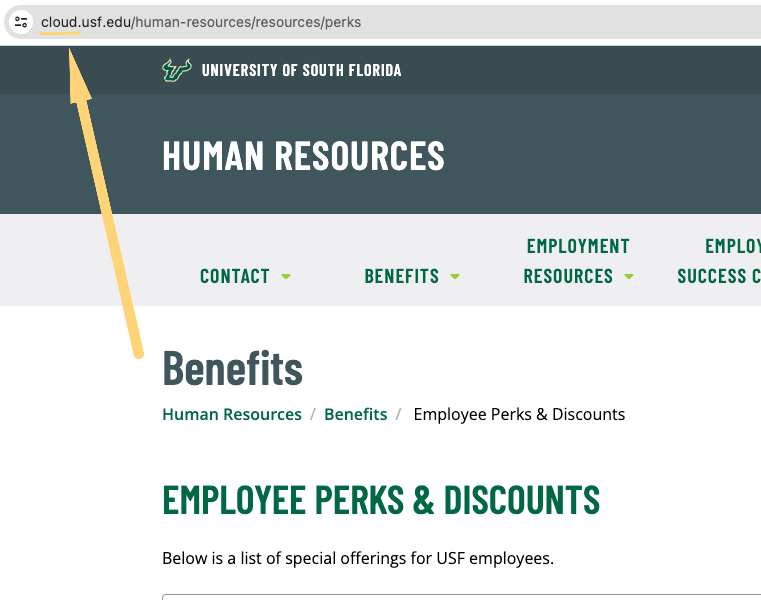
The general consensus is that subdomains don’t pass the same value as the root domain. In fact, Google has even said it views subdomains as its own domain.
So, the DA 87 value doesn’t necessarily apply to the subdomain.
So, unless it is a relevant fit from a well-known brand, I tend to skip any subdomains when doing resource page link building.
Another common technical assessment in resource page link building looks at page depth.
Pages buried far within a site are less valuable from an SEO perspective because they are likely not crawled as frequently.
The easiest way to assess page depth is by clicking through.
For instance, the University of Florida page is four clicks from the home page.
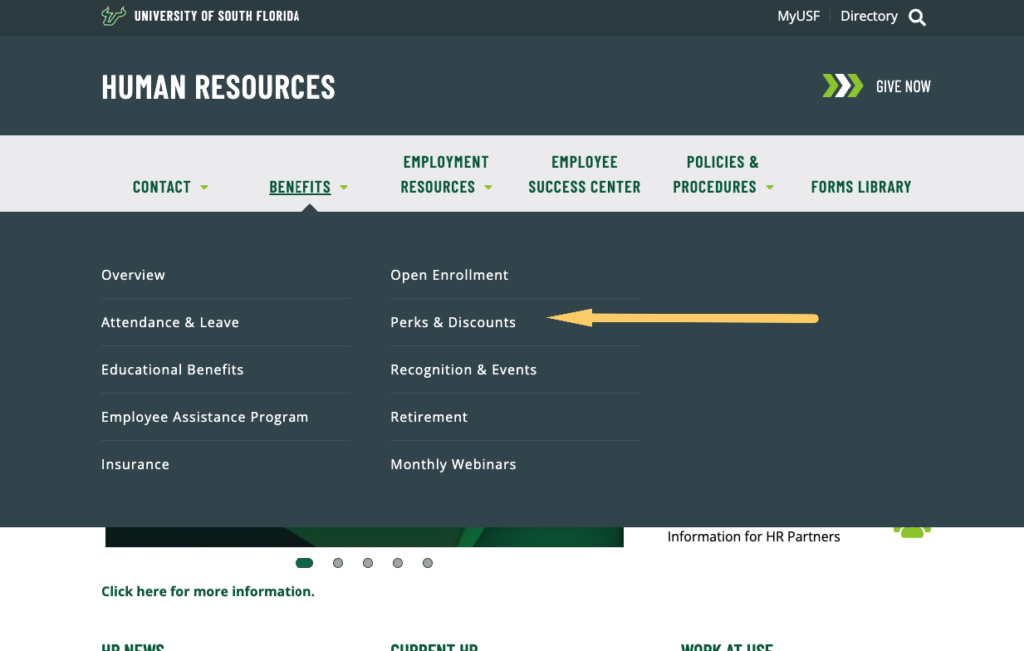
Google does mention that click depth matters. If users can’t find a page, it will be less valuable.
Aim for no more than 3-4 clicks from the home page.
Another assessment is the number of external links on the page. It’s a page with 100+ external links, so whatever link value it has to pass on is extremely diluted.
As I explain in our post about quality links, avoid pages with many outbound links.
So, while the content looked OK, the authority itself isn’t as high as it seems.
Lastly, resource page owners have most likely been spammed many times in the past, so it’s important to distance yourself from them.
Most who send in bulk don’t personalize.
So, I recommend building a scalable approach for personalizing emails. Even if this is going to a webmaster who may not care at the end of the day, if he/she receives 10 emails and yours is the only one that says something specific, it may increase your chances of getting that link.
Using BuzzStream, you can add personalized messages while still hitting the volume you need to move the needle.
Personalizing with BuzzStream
BuzzStream allows me to set up templates and sequences to send for each campaign.
I’ll set up my template with standard mail merge fields like First Name and site Name, but I’ll also create custom fields to add personal line that I can write on the fly.
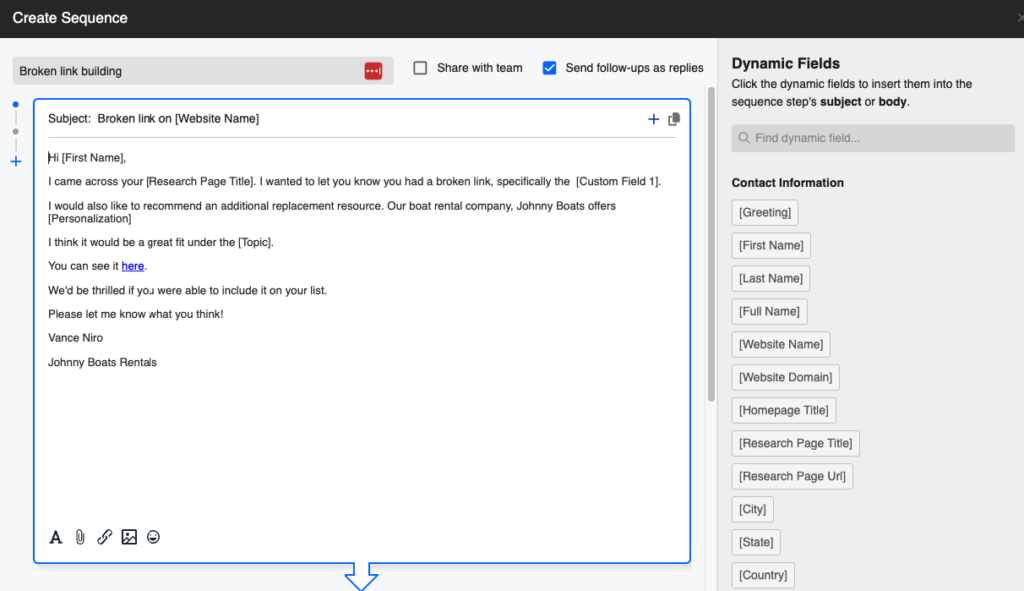
Using sequences, I’ll automate a follow-up to ping the blogger with a new, shorter message after 4 days.
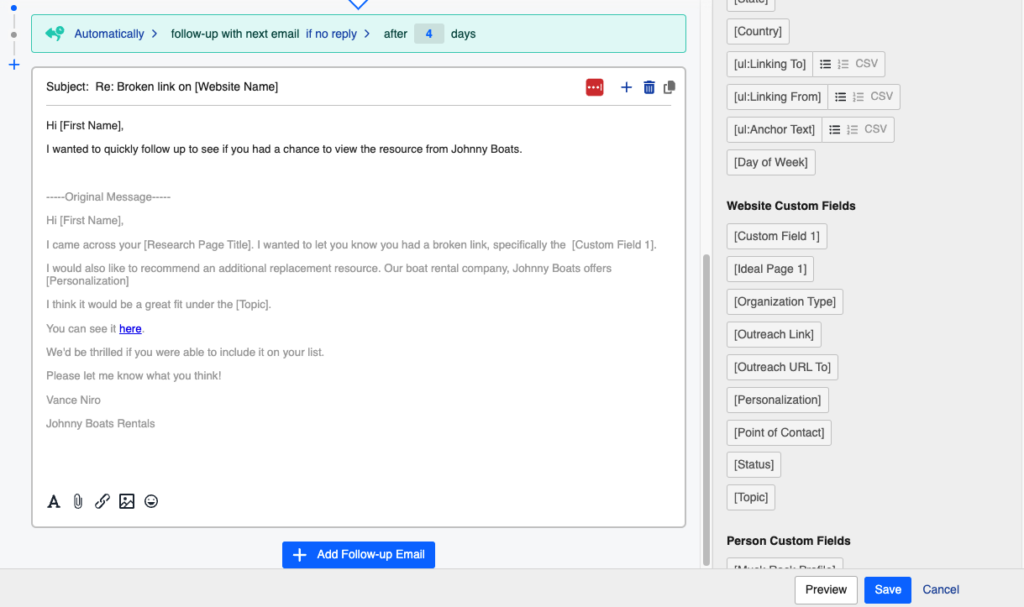
Then, when it’s time to personalize the email, I’ll use the Chrome Extension BuzzMarker to view the page I’m on, extract any details I need to personalize, and then write the email—all without leaving the tab.
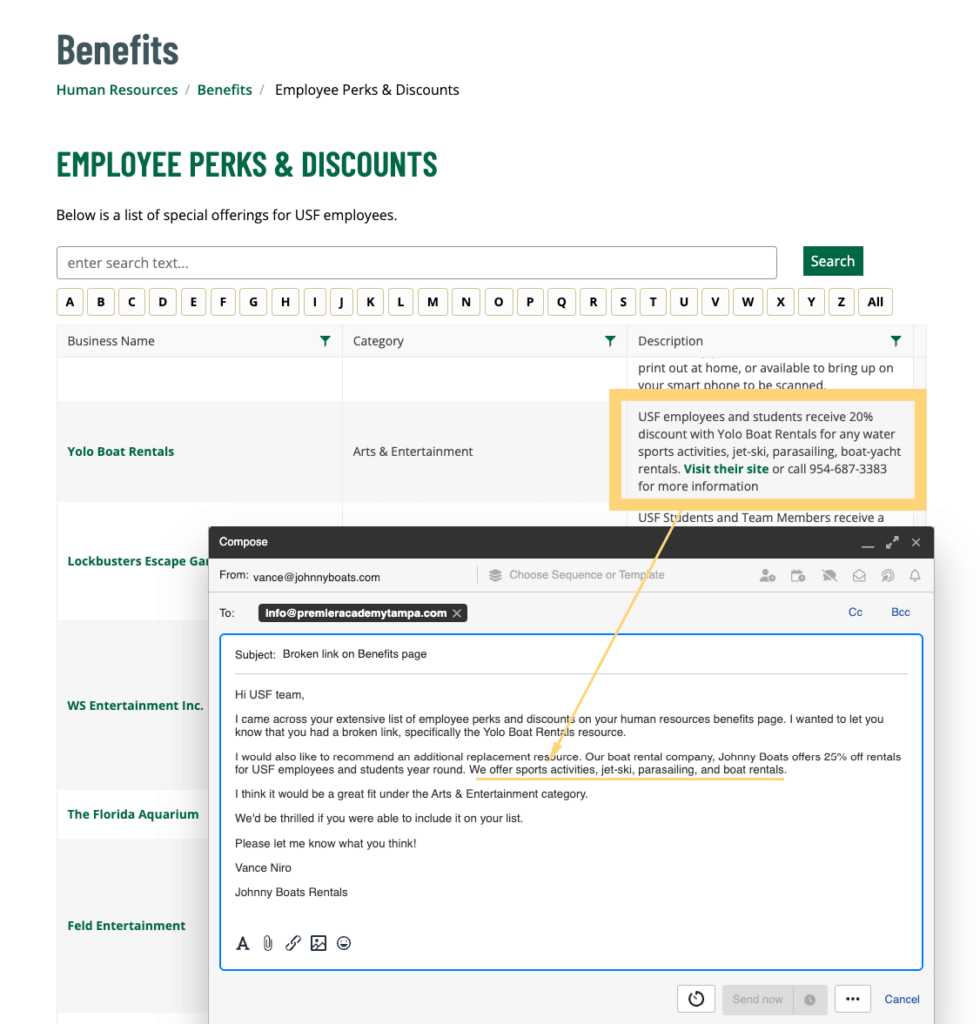
I’ll also create a backup recipient to ensure my email is sent.
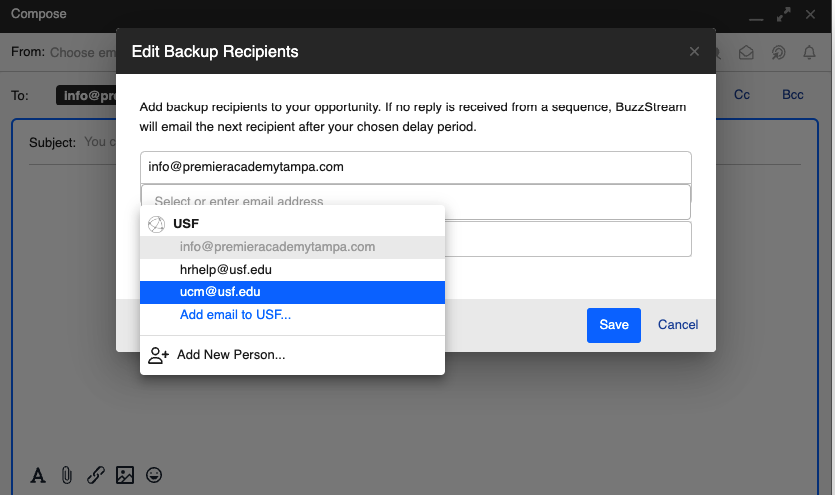
Setting up outreach flows like this helps me scale my campaigns but still allows for the personalization needed to cut through the noise.
Exchanging Links With Other Sites
Link exchanges are a common way to build links in the SEO community. There are some risks involved with these approaches. But there are essentially two main tactics:
- Two-way link exchanges
- Three-way link exchanges
13. Two-Way Link Exchange
TL:DR: Use sparingly, only for brand building.
One-to-one link exchanges, or reciprocal links, aren’t the industry standard anymore. Before my time, SEOs used to use them all the time.
You ask someone to link to you if you link to them. Reciprocity. It seemed so easy.
Google eventually caught on and still maintains that excessive link exchanges are spam, which hasn’t changed.
So why do people do it?
Because reciprocal links can happen naturally, it’s harder for Google to determine.
Let me give you an example.
We often link to Ahrefs because it’s a commonly used SEO tool. Similarly, Ahrefs often links to us because we are a tool for link building.

So, should Google penalize us?
No. However, Google has put some safeguards in place so that we don’t get an authority boost each time we link to one another.
Does It Still Work?
Reciprocal linking was most likely not impacted by Helpful Content in any way.
You shouldn’t write content differently because you are worried about reciprocal links. If a link naturally exists in a piece of content, that’s great.
However, I wouldn’t rely on building your link building strategy around this tactic.
Remember, excessive link exchanges are what Google warns against. With all of their data, they can most likely connect the dots to see when sites’ backlink portfolios line up too closely.
How to Be Effective in 2024
Think of two-way link exchanges as brand-building and relationship-building.
In this way, it becomes more like ego bait or mention outreach rather than a scaled link building approach. If you mention a brand in your post or use some data from another post, reach out and let them know.
Don’t set out to say hey, I’ll link to you if you link to me. That’s the kind of thought process that can get you into trouble.
Most people’s thoughts at this point are: If Google can figure out one-to-one reciprocal linking so easily, why don’t we just add a middleman?
That brings us to the next tactic.
14. Three-Way Link Exchange
TL:DR: This tactic is highly-used, but it can be risky business depending on who you’re exchanging with.
Three-way link exchanges involve three sites instead of just two:
Site A links to Site B.
Site B links to Site C.
Site C links to Site A.
The whole purpose here is to obscure the visibility of the link exchange happening.
That said, this is an incredibly common link-building tactic that has spawned entire agencies over the years. Because of the technological overlap, you tend to see it more with SaaS link-building.
Honestly, I have never taken part in a three-way link exchange, and to explain why, let me get into a little bit of how they work on the back end.
To scale it, link builders and agencies need to amass many sites interested in participating in this approach.
You’ll see messages mentioning a network of sites or partners:
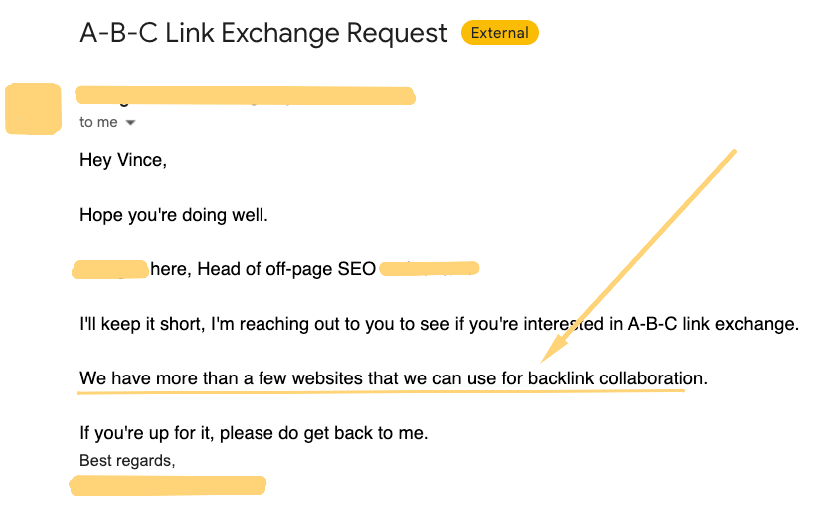
OR
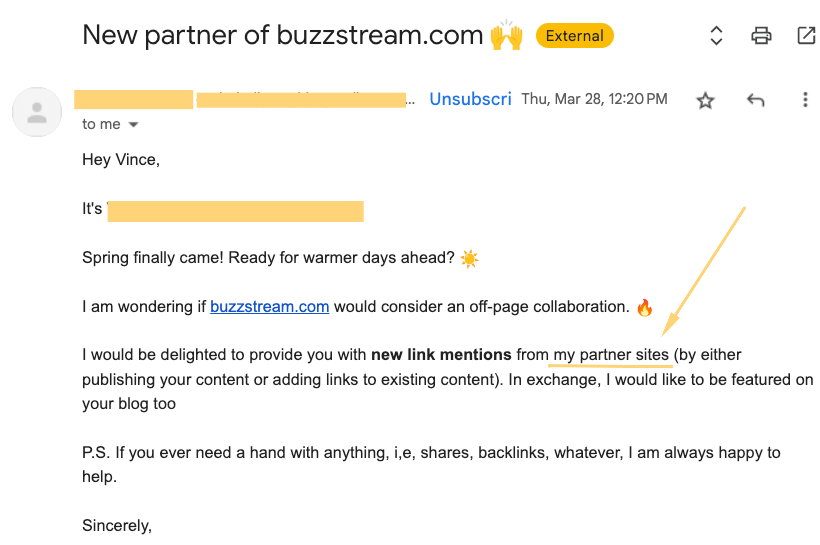
When you start working within a network, the risk increases tenfold. At the start of this post, I mentioned Brian Dean’s podcast about how getting links in “bad neighborhoods” can hurt you.
The same risk exists here.
All it takes is for a few of the sites in the network to go sour, and you start souring the whole network.
Does it work?
Three-way link exchanges work, based on virtually everyone I’ve talked to who does them, with no adverse effects.
So, if you’re having success, there’s no real reason to stop after Helpful Content.
Again, the main thing to be wary of is the quality issue. Whenever you get into scaled link building, you run into sites that exist solely to build or sell links.
So, you are in trouble if a link exchange network is full of low-quality sites.
But if people do it and succeed, they do something right. So, let’s look at how.
How to Be Effective in 2024
To effectively use three-way link exchanges, you must be smart about who you partner with and how much you partner.
Choose partners that have healthy link profiles. You can do this by looking at the number of quality backlinks they have.
In my post about the quantity of backlinks you need, I run through using Ahref’s “Best Links” feature.
For instance, it’s much less when we compare the number of total backlinks that Mailchimp had to the number of quality backlinks.
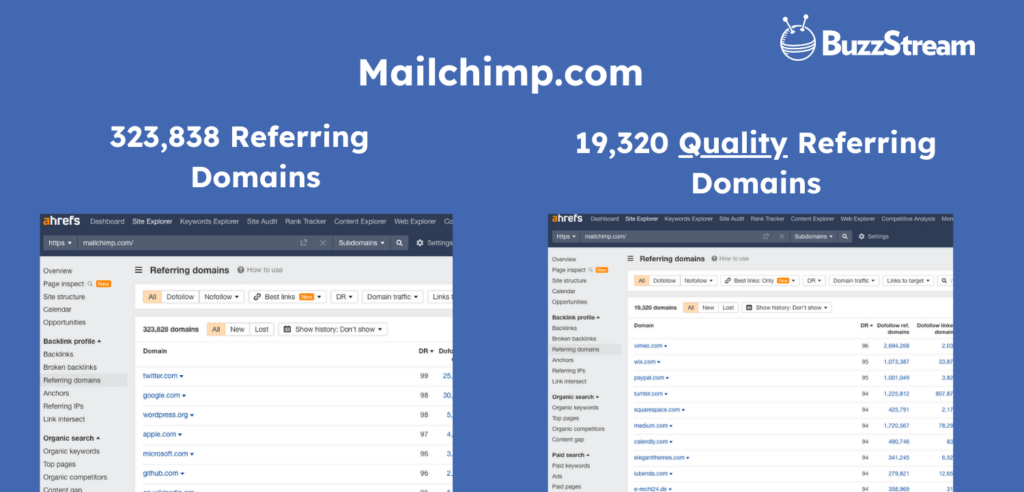
The strength of a backlink profile can help determine whether a site has been involved in “bad neighborhoods.”
Second, this is a risky tactic, so use it carefully. Don’t rely solely on this for link building.
The Perfect Link Building Strategy is…
A tactical mix of content-led digital PR and passive link building. Support those with reactive and proactive quote pitching, podcast outreach, and guest posting for your brand. Look for unlinked mentions as you grow.
Obviously, there is no one-size-fits-all strategy. Things change, and markets adapt.
That said, my above mix looks like a safe and highly effective bet. This is 100% the approach I personally use and advocate.
Here’s why:
These are all natural ways to build links. I mention each tactic in my white hat link-building post because each tactic is safe in Google’s eyes and effective based on my personal agency experience.
Google’s Helpful Content system is built to reward original research, which is your content-led digital PR and many passive link-building keywords.
Google likes expertise and experience – show this with your quote pitching, guest posts, and podcasts. This will also increase your brand awareness, bringing more people to your site over time, and help Google more closely associate your brand with your industry, helping you rank better.
Unlinked mentions are added bonus links, so why not?
Then, remember these three tips:
Stay Nimble
The best SEOs and link builders are the ones who can think on their feet and remain flexible. When Google changes, you must adapt rather than dig in your heels.
Google constantly tries to prevent people from gaming the system. If something sounds too good to be true (like buying links from a marketplace or creating a network of sites to link back and forth between), it probably is—or will be soon enough.
Avoid Sites That Appear on Lists
You can easily find lists of sites that accept guest posts, link insertions, or link exchanges.
I receive them via LinkedIn messages from sketchy folks pretty much daily. They look like this:
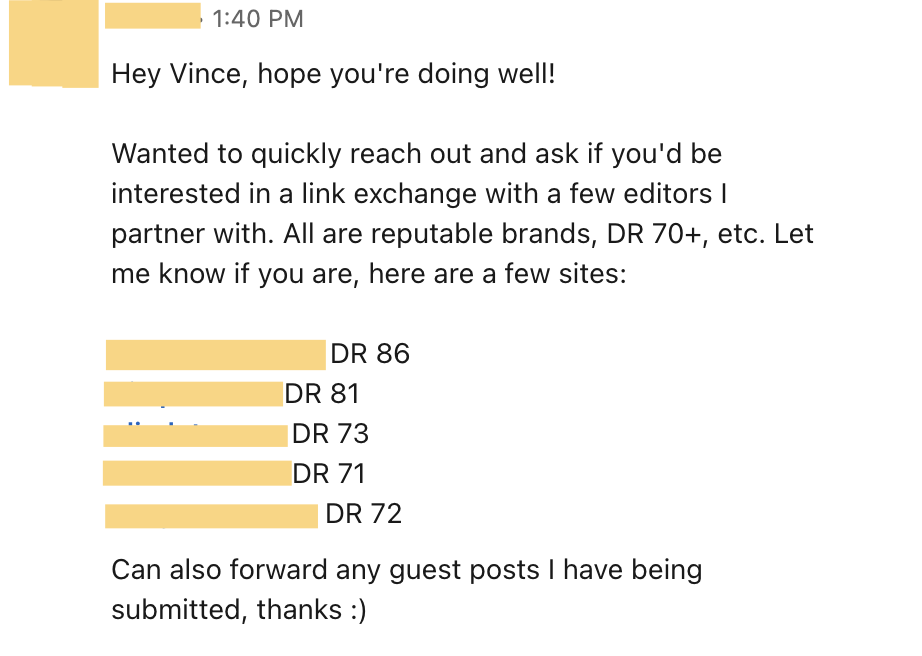
First, most of them ask for money, which is a direct violation of Google’s guidelines, something they’ve posted about again and again and again.
In 2022, they even announced using SpamBrain to fight against sites buying and selling links.
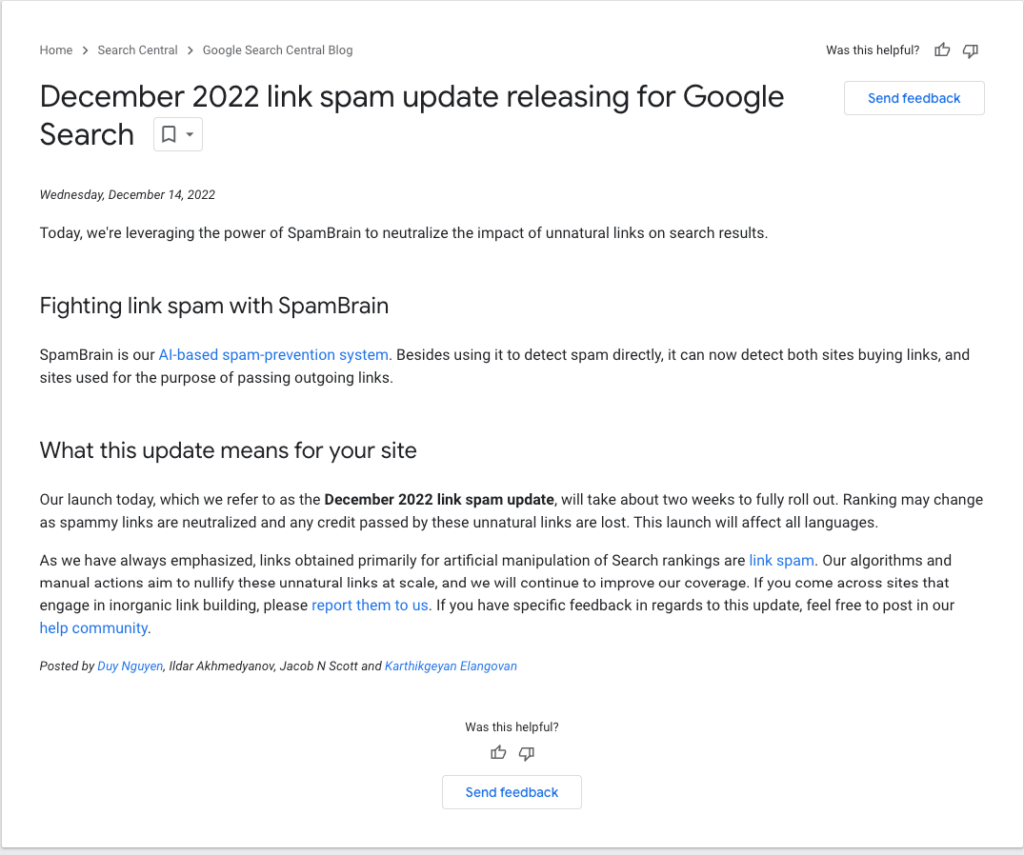
But, more importantly, the more users have access to such lists, the lower the quality of their links.
This is most likely because they are providing low-quality content and exist just to place third-party links.
To be successful with link placements going forward, you must evaluate the site for quality.
Evaluate the Content for Quality
I know I sound like a broken record, but Google is pushing everyone to judge their content for quality with the aforementioned self-assessment.
Don’t think Helpful Content makes a difference?
After the March 2024 Core update, I quickly analyzed some popular guest posting and link exchange sites that I found from a spreadsheet I shared online.
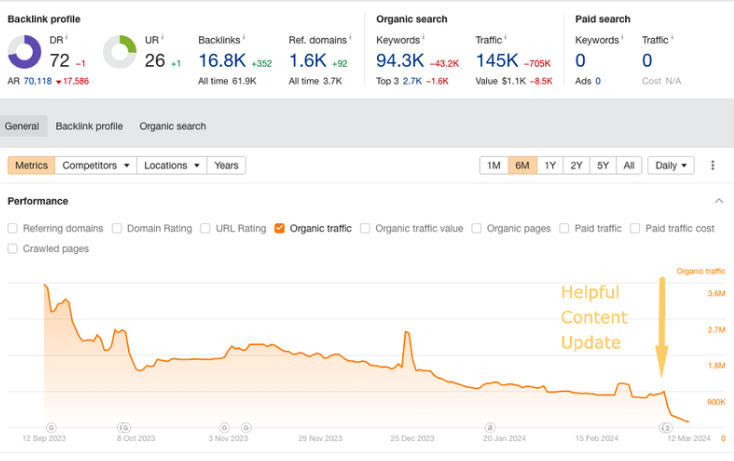
Several dropped traffic immediately after the algorithm update or consistently since the initial Helpful Content announcement in 2022.
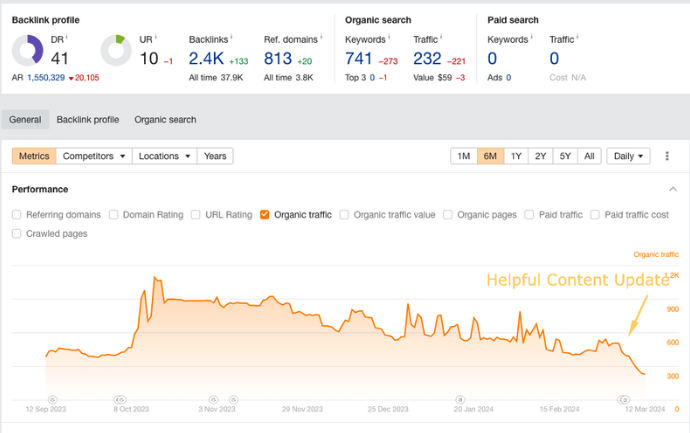
So when you aim to place a link when building a resource page link, for example, evaluate the page itself.
Is the site quality quality if it’s just a list of links?
If you are doing broken link building, aim to get links from quality sites; don’t blindly reach out to all of them.
Will AI Impact Your Link Building Strategies?
Unfortunately, no one knows the answer to AI’s impact on link building. So I don’t have much to say that you haven’t read a million times before.
But I can’t write about link building in 2024 without mentioning AI, so I’ll leave you with this:
When I think of AI and link building, I don’t think of ChatGPT or Bard and links appearing in search. I think of LLM and its ability to work through data.
They have access to much more data than we ever will.
So, the more you get bogged down with dodging and obfuscating Google, remember that they are working with things like SpamBrain to find patterns you may not even know exist.
You can win by building links naturally through great content and sound outreach tactics.

 End-to-end outreach workflow
End-to-end outreach workflow



 Check out the BuzzStream Podcast
Check out the BuzzStream Podcast







